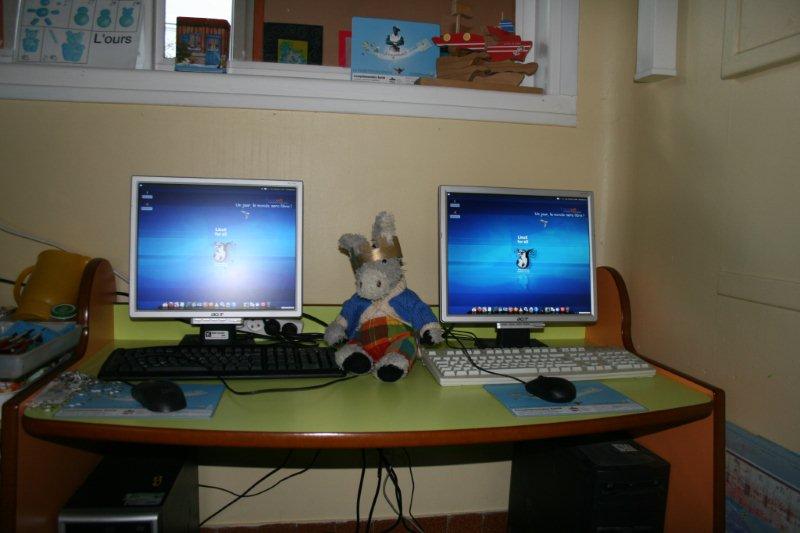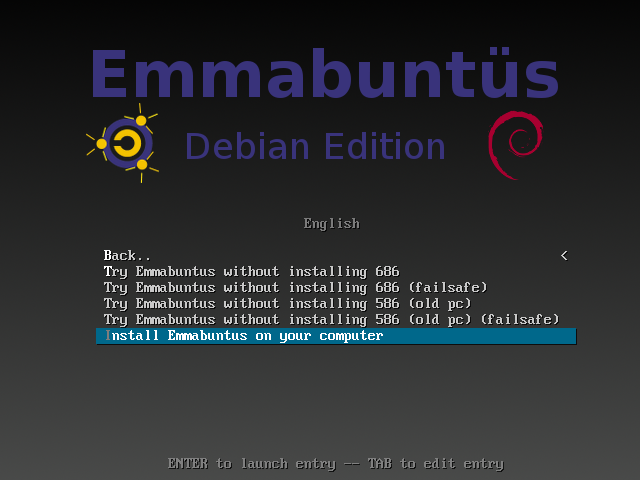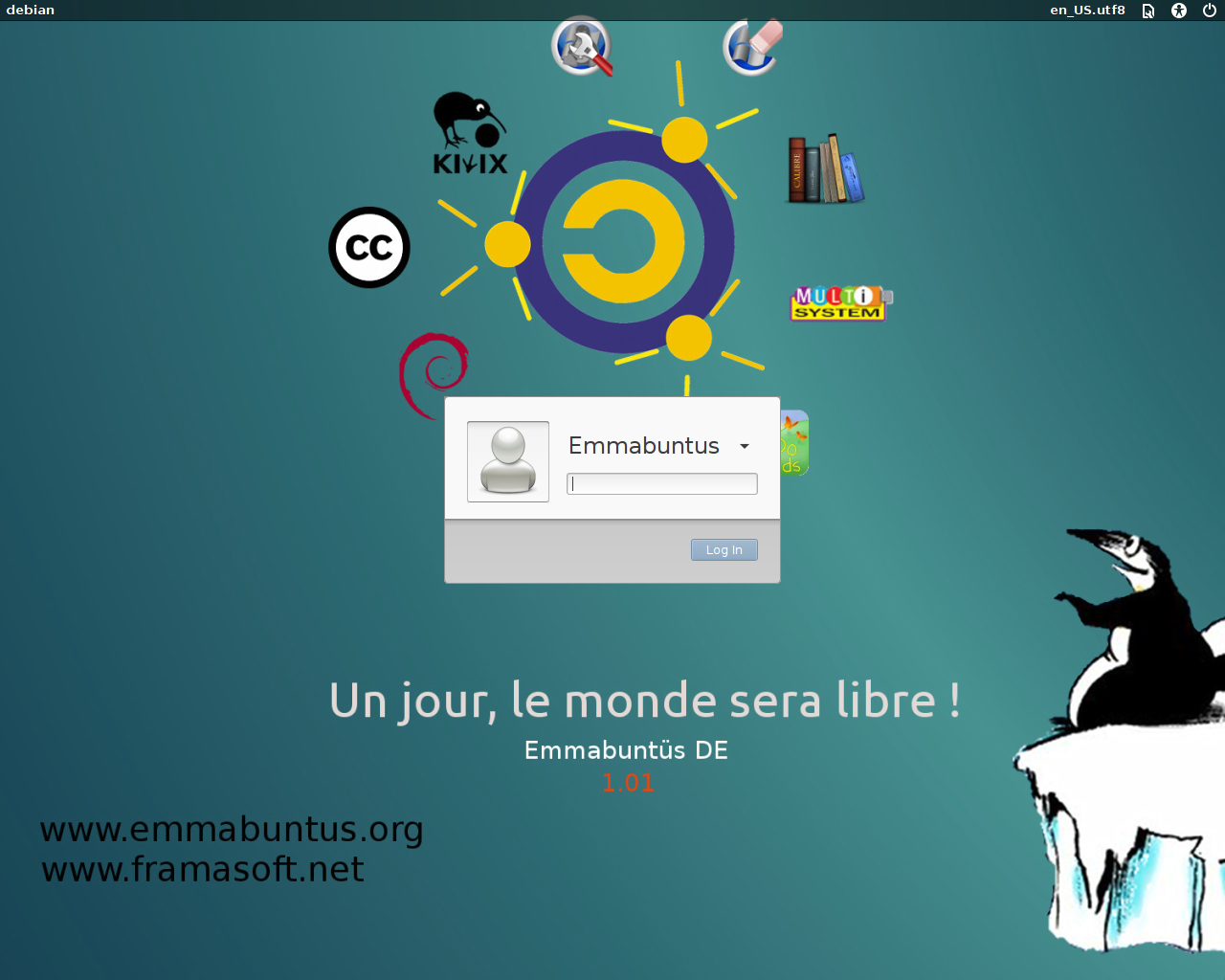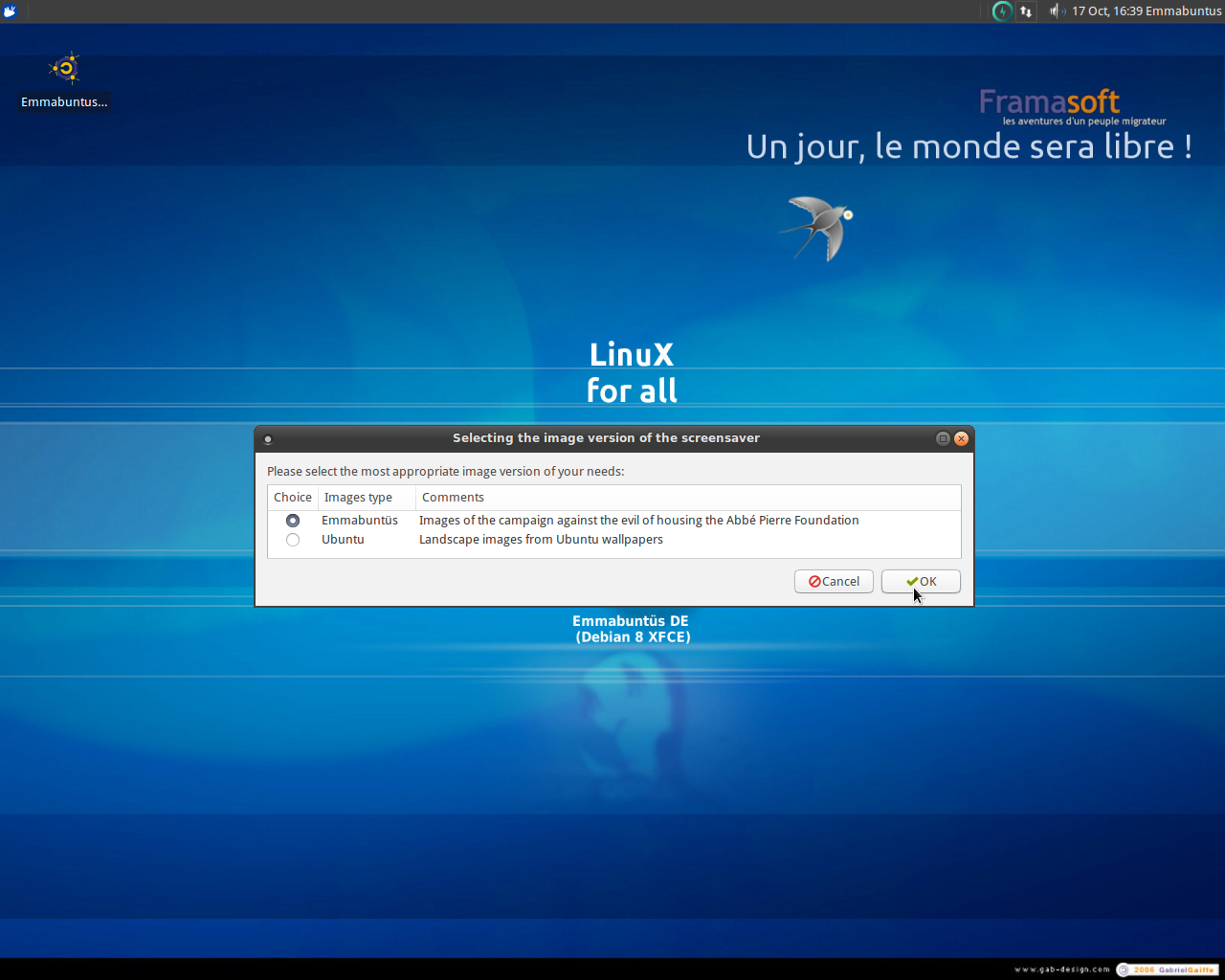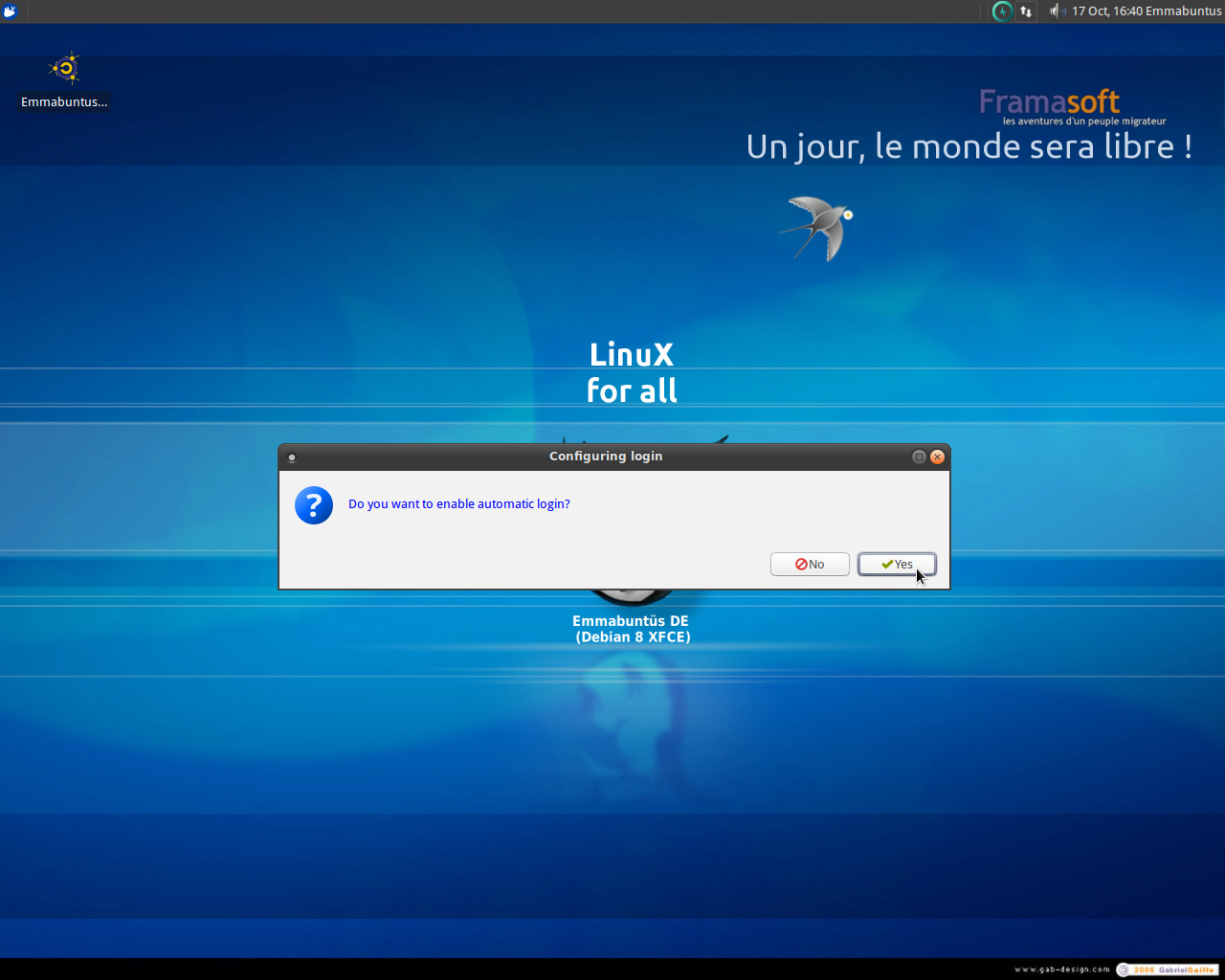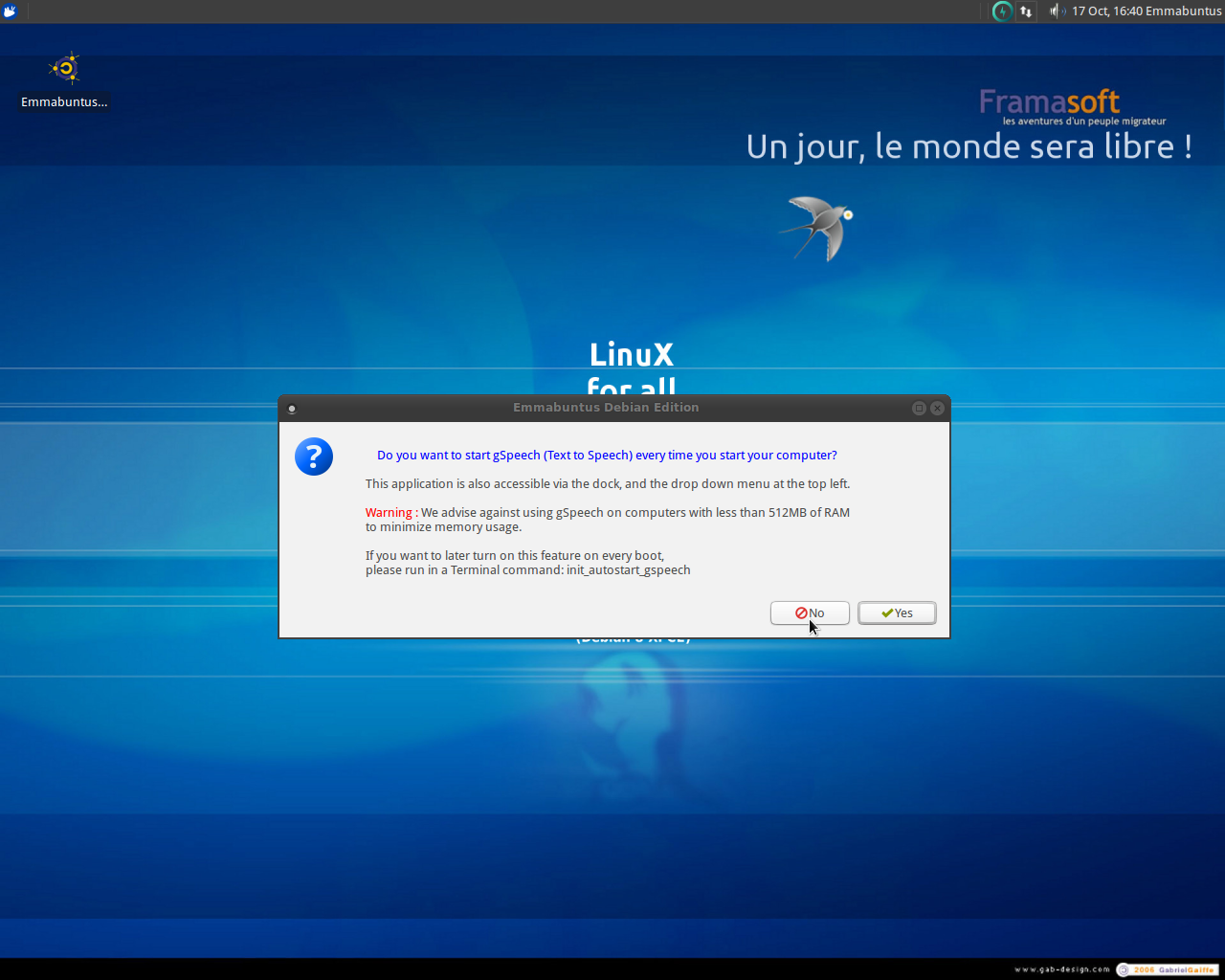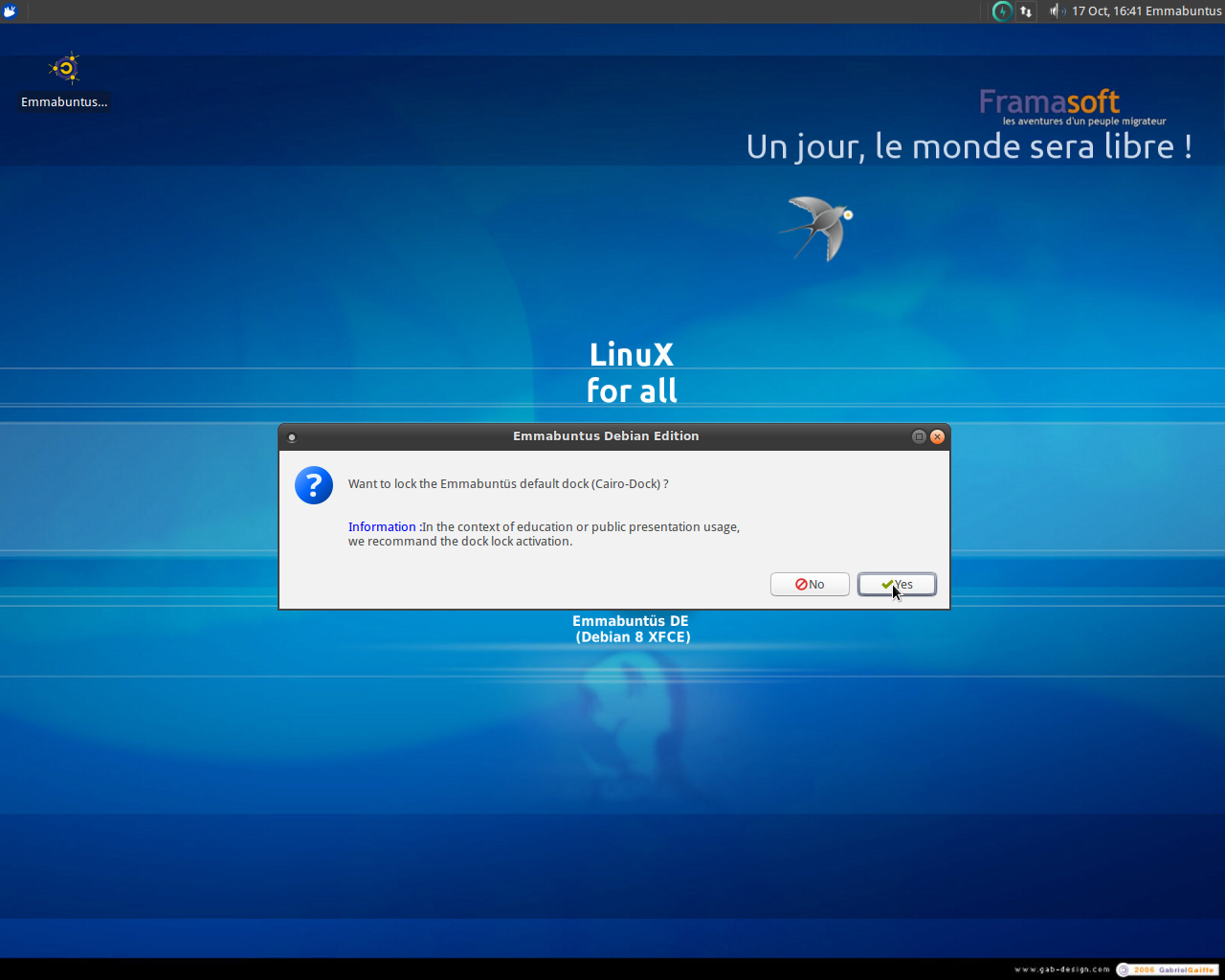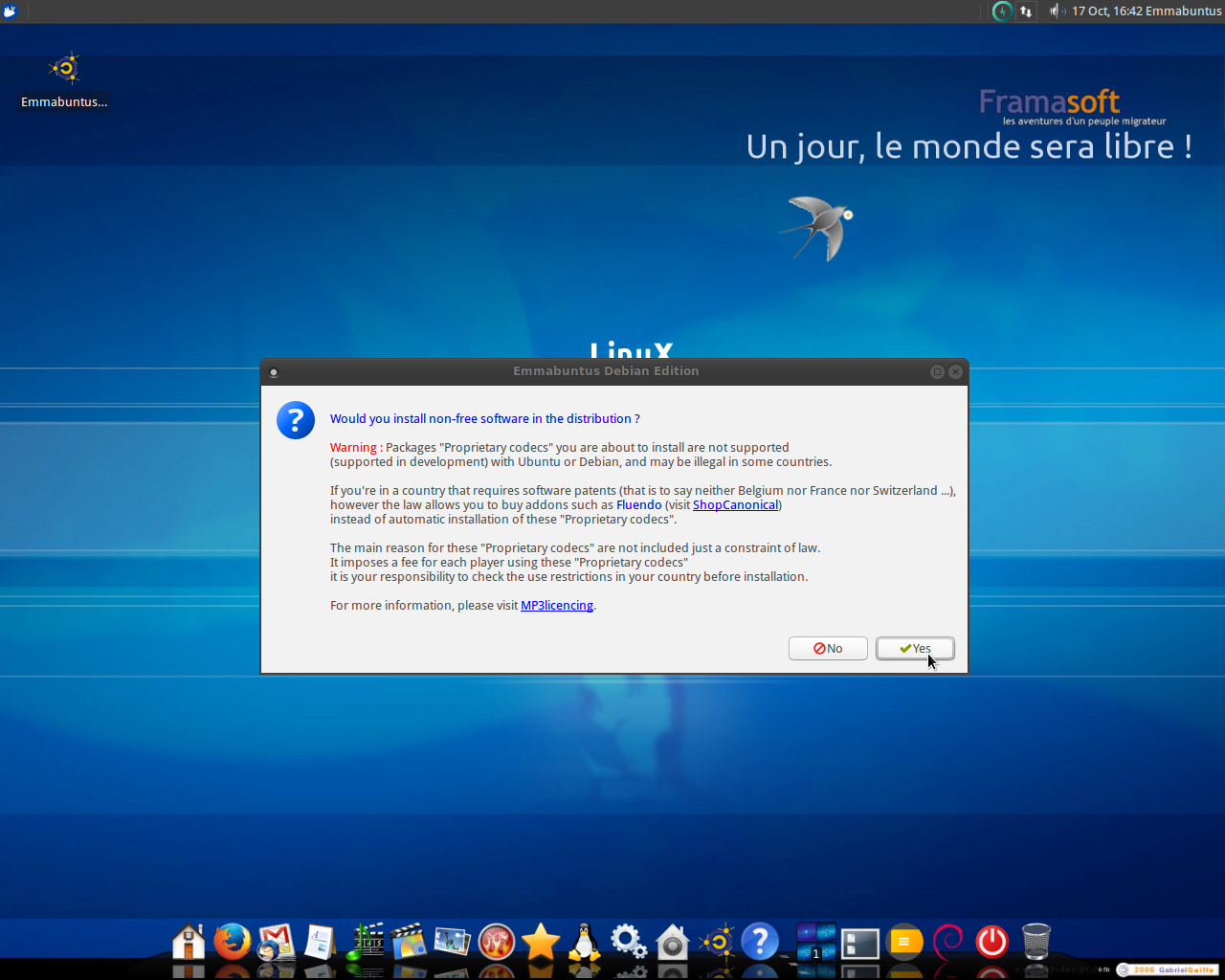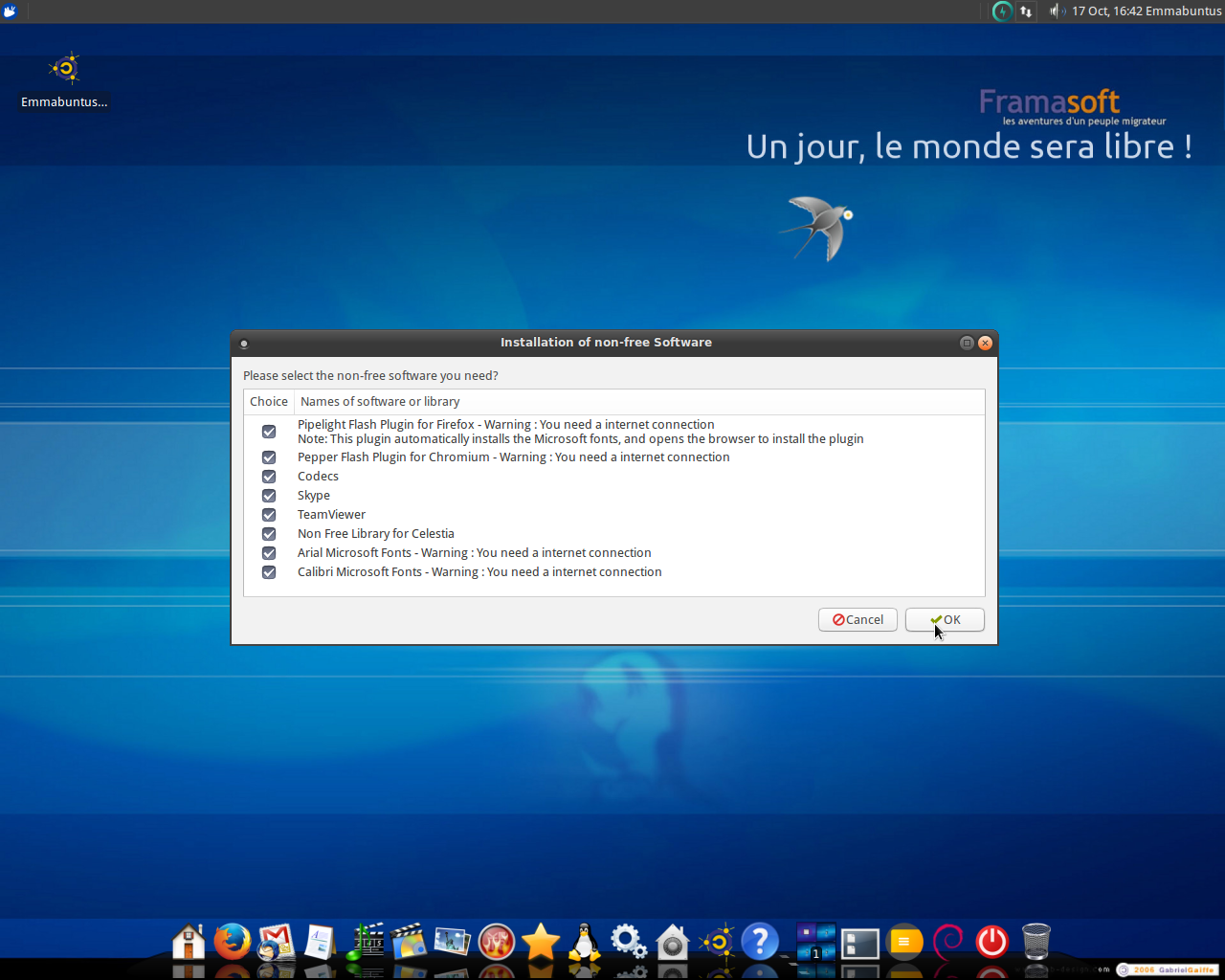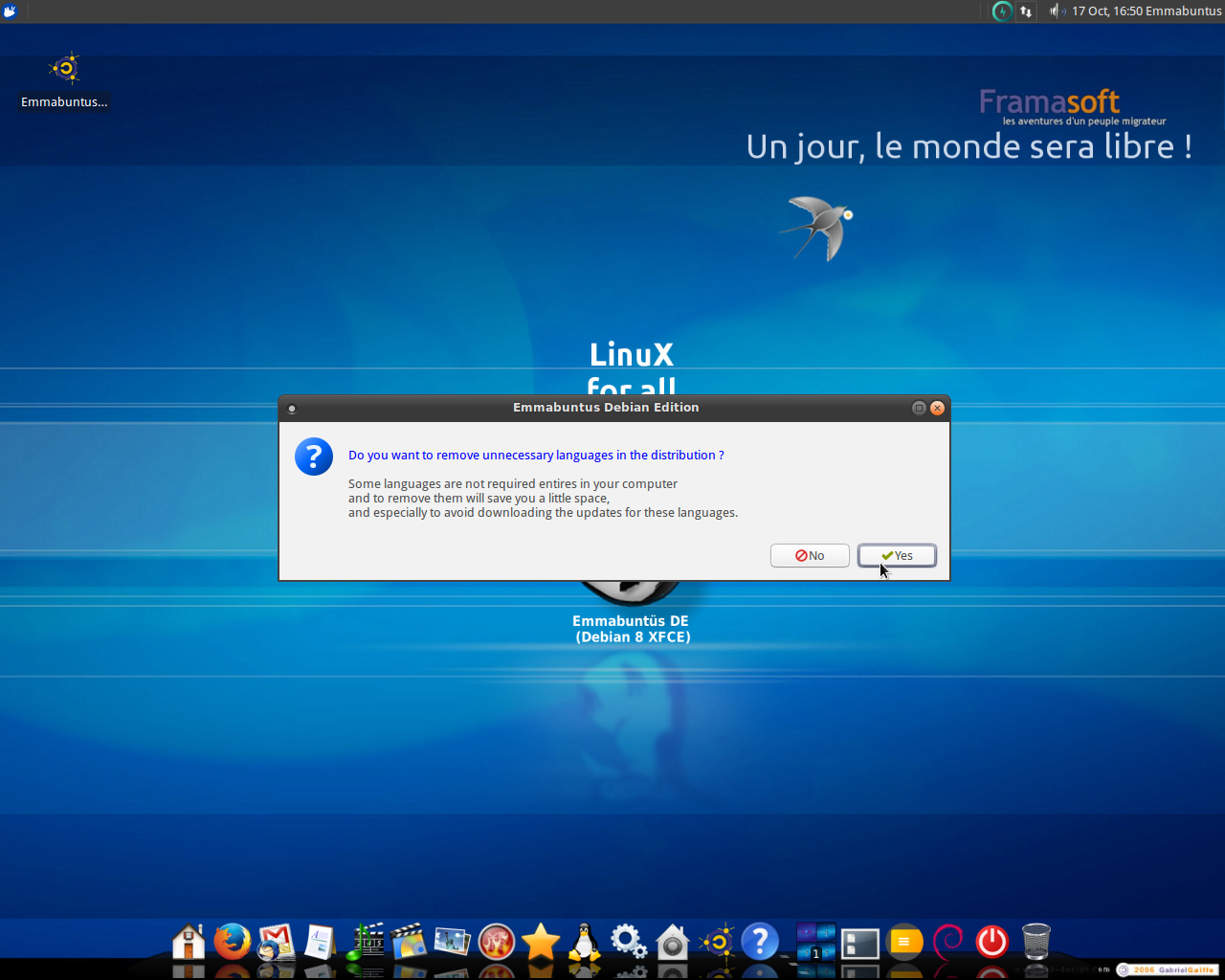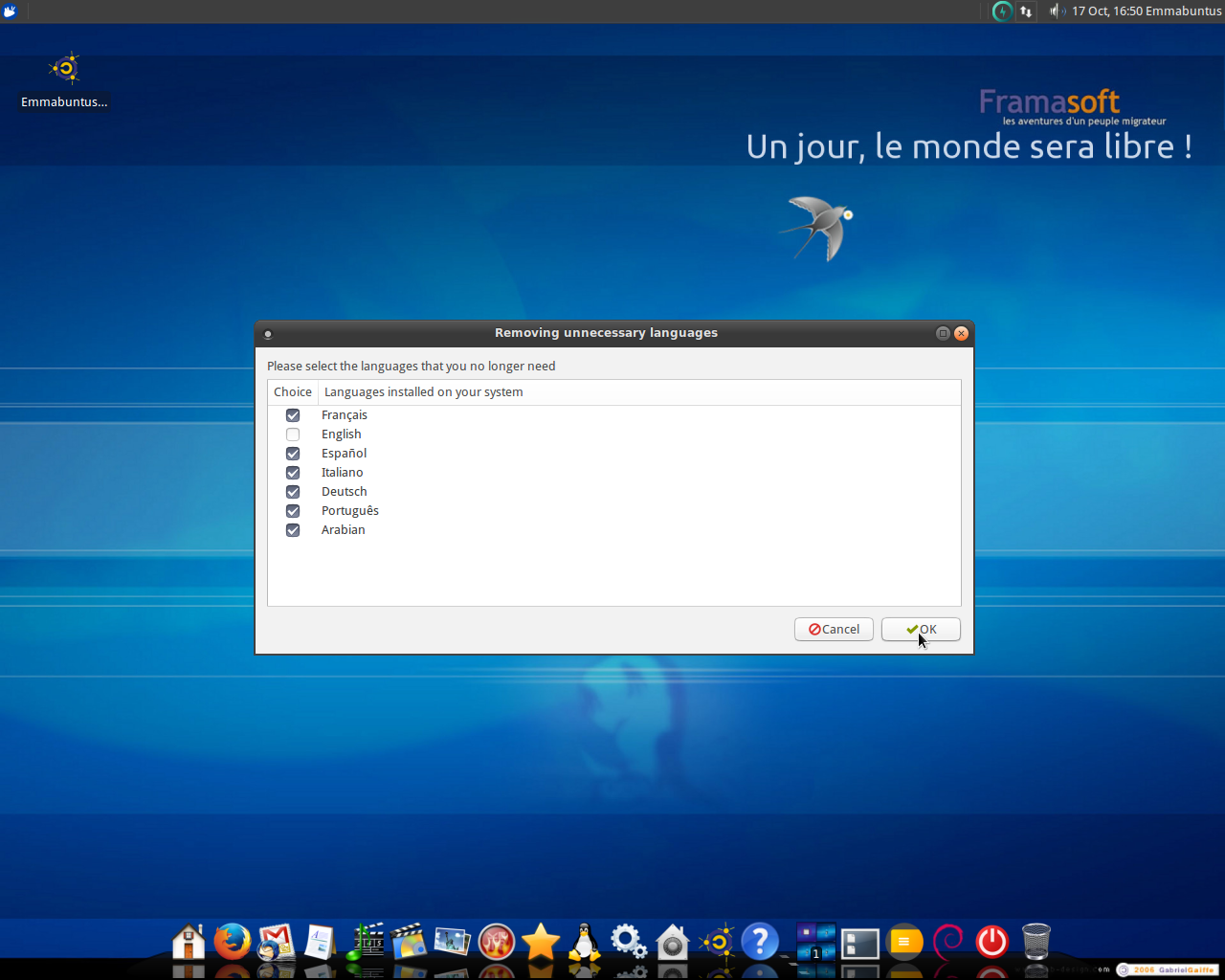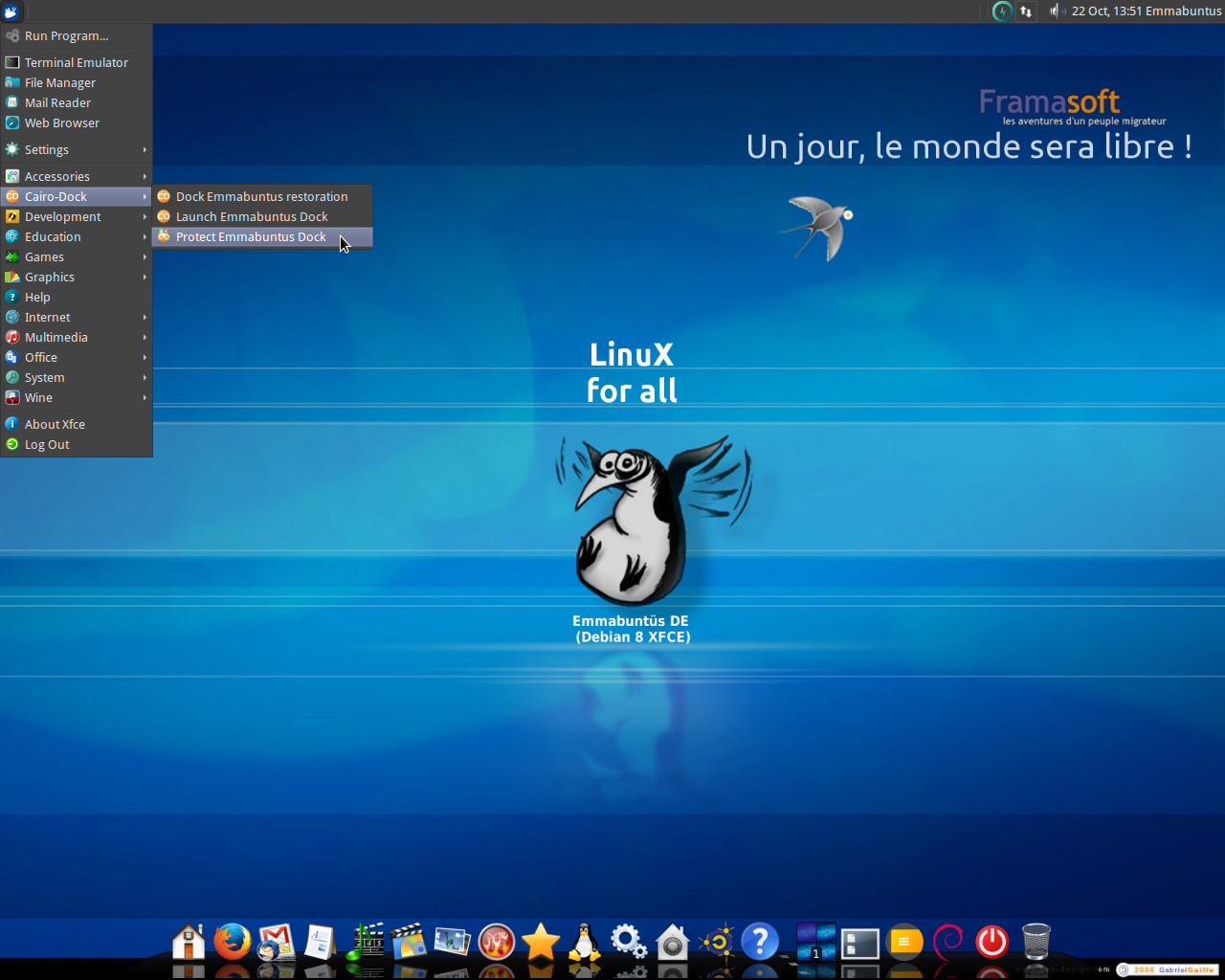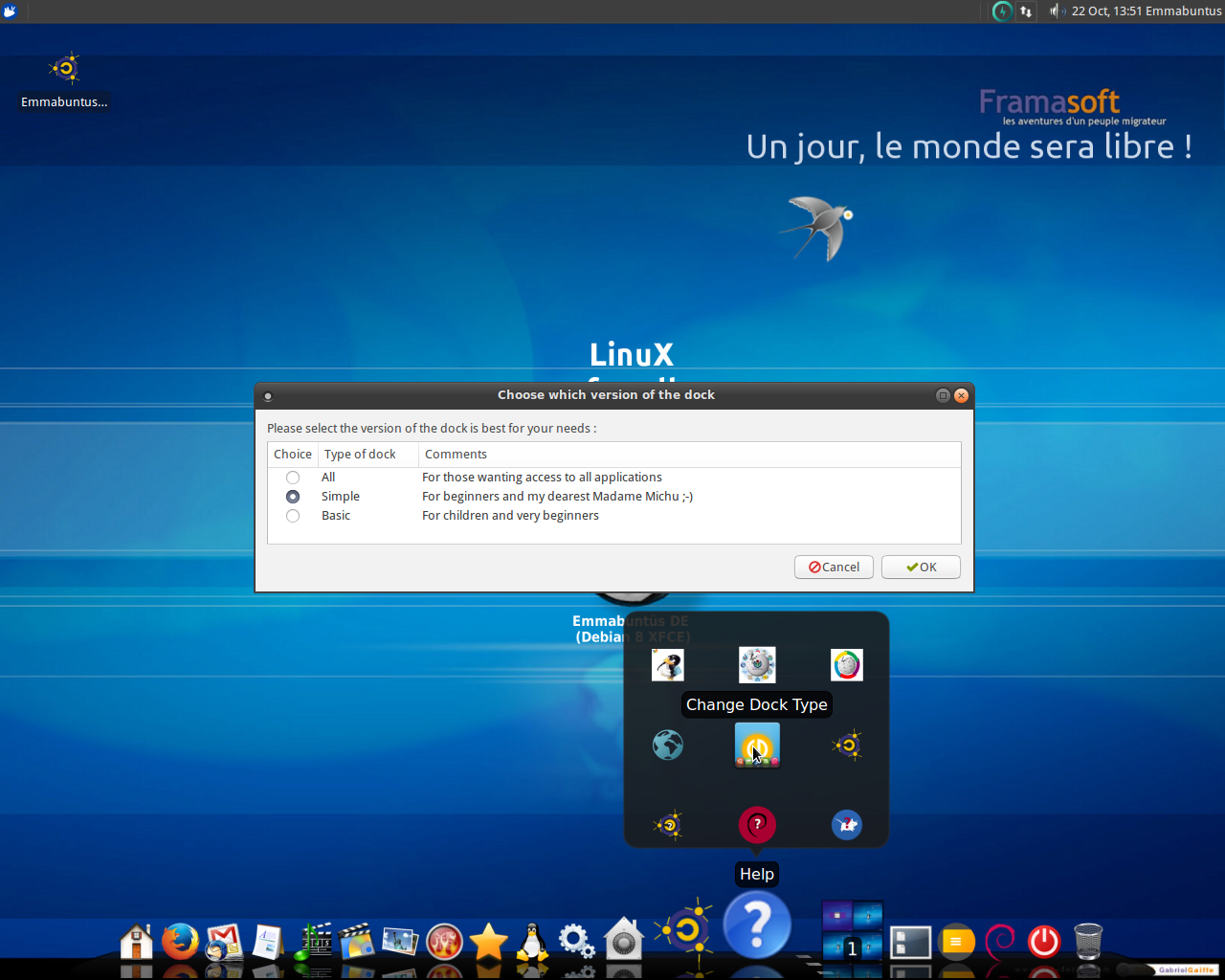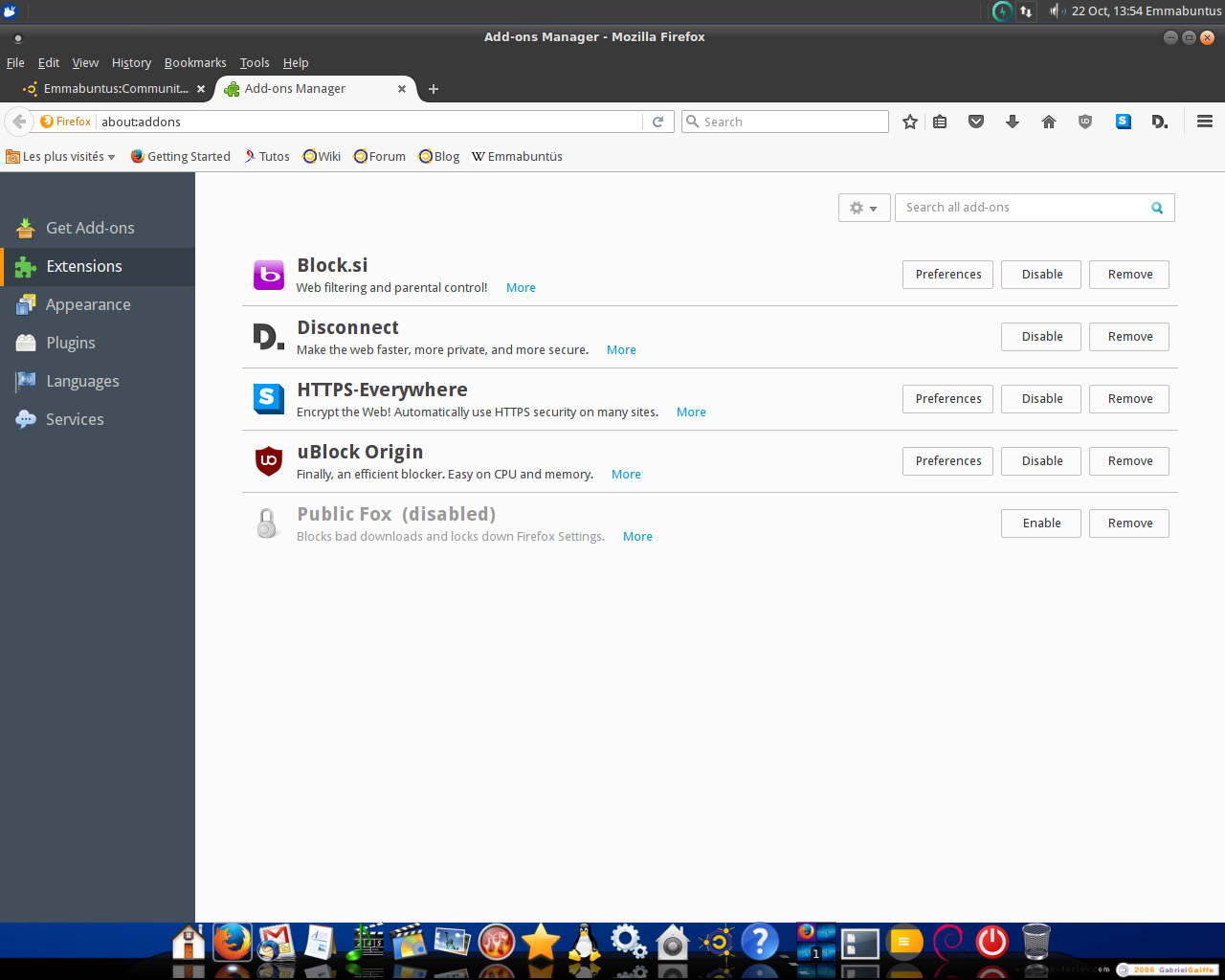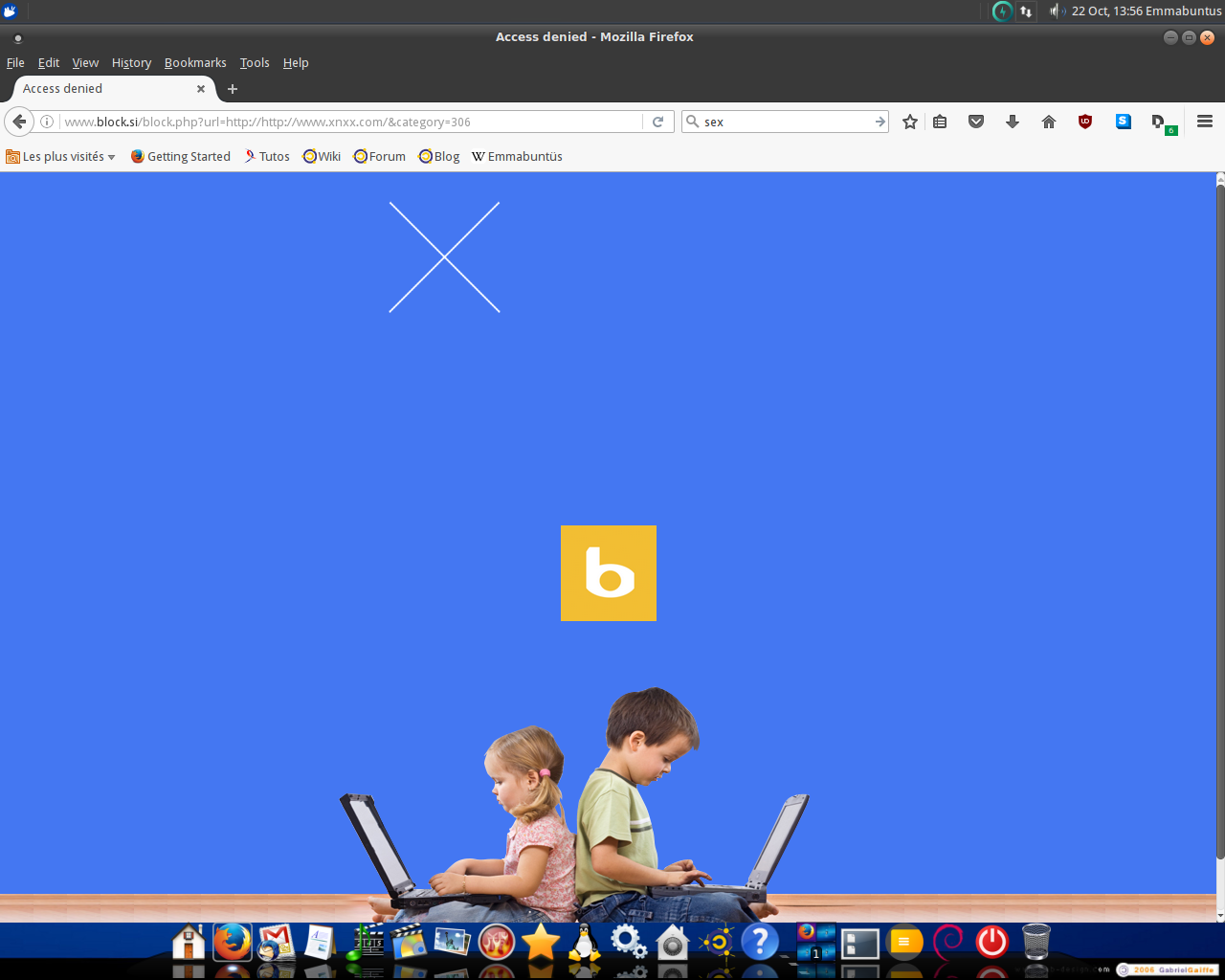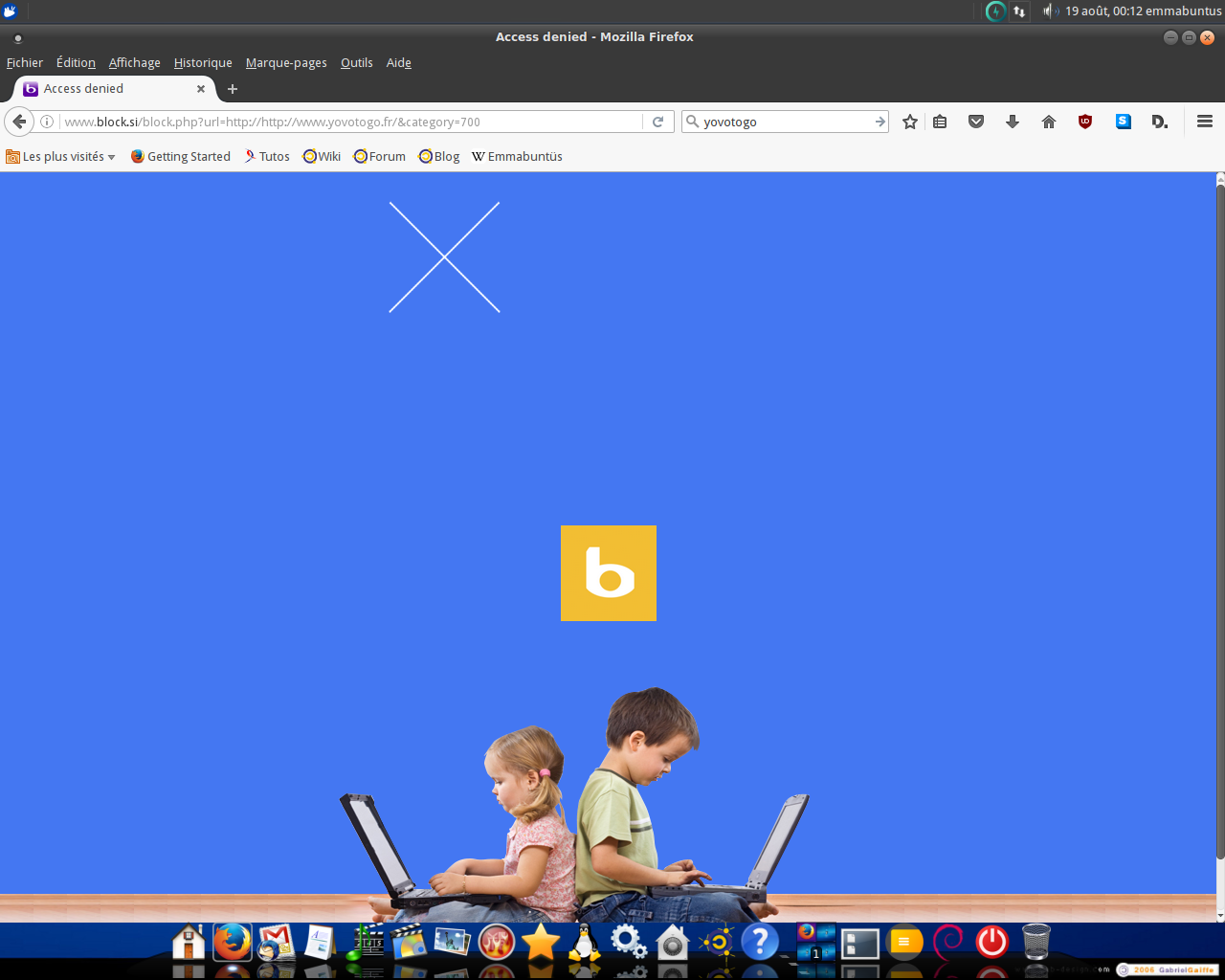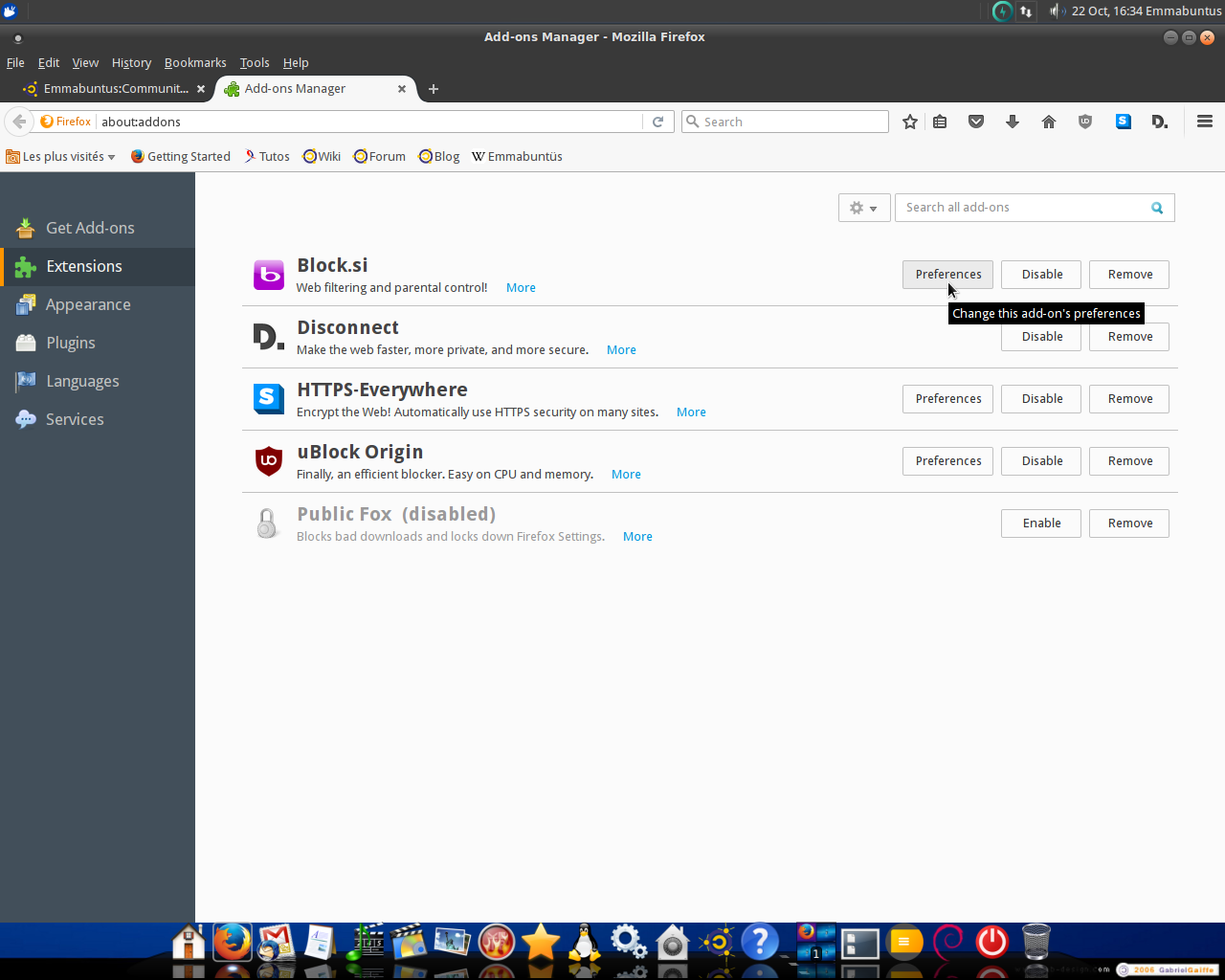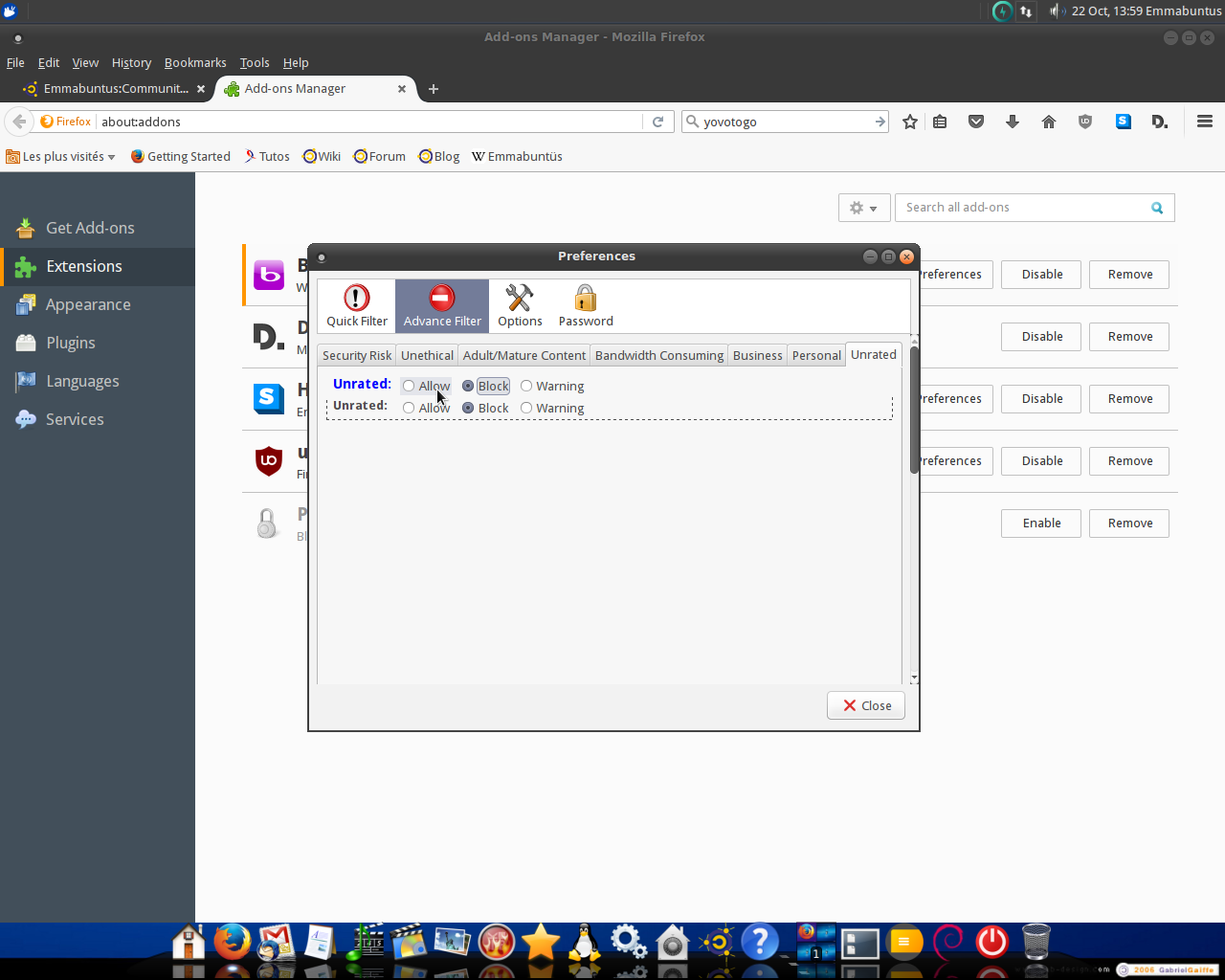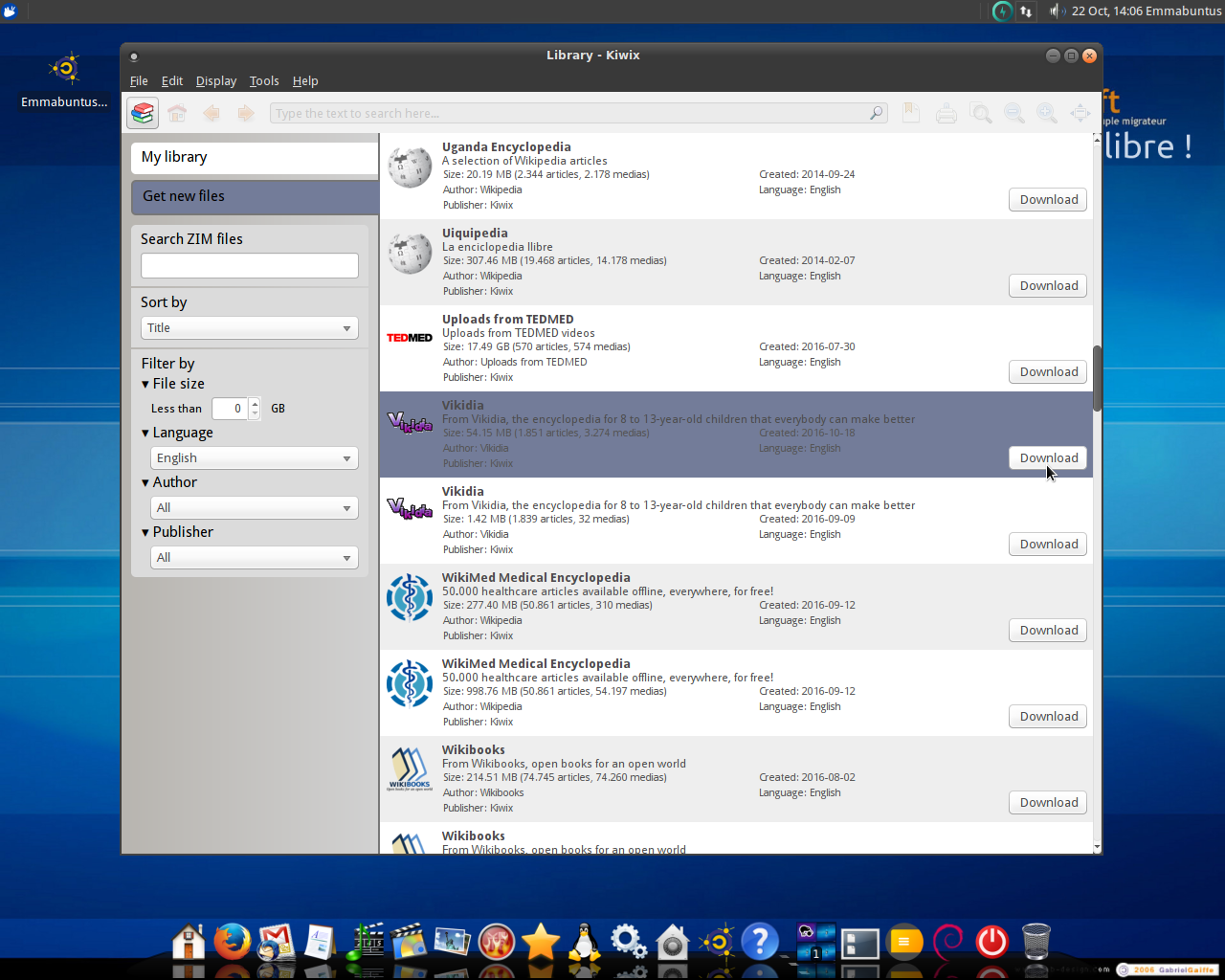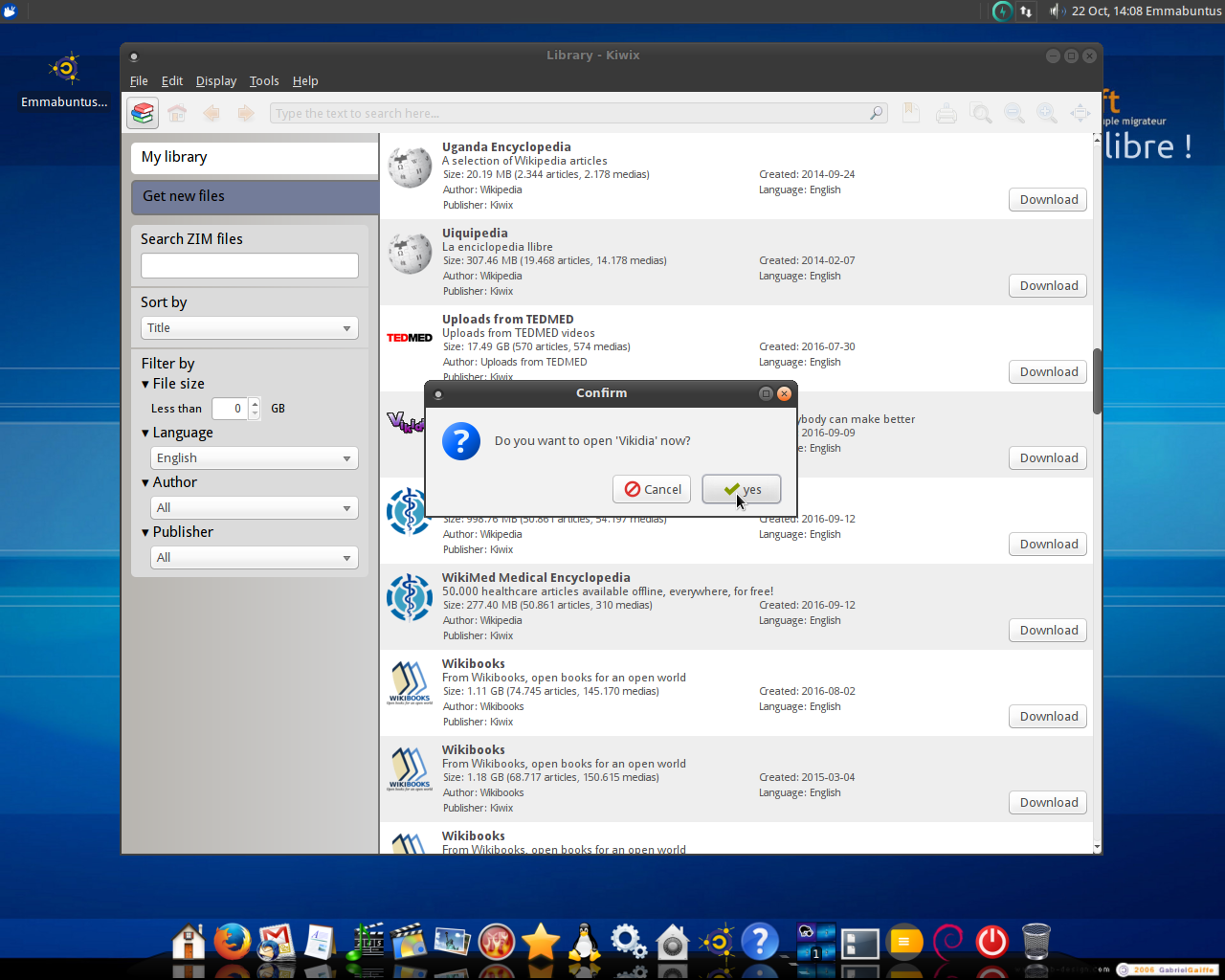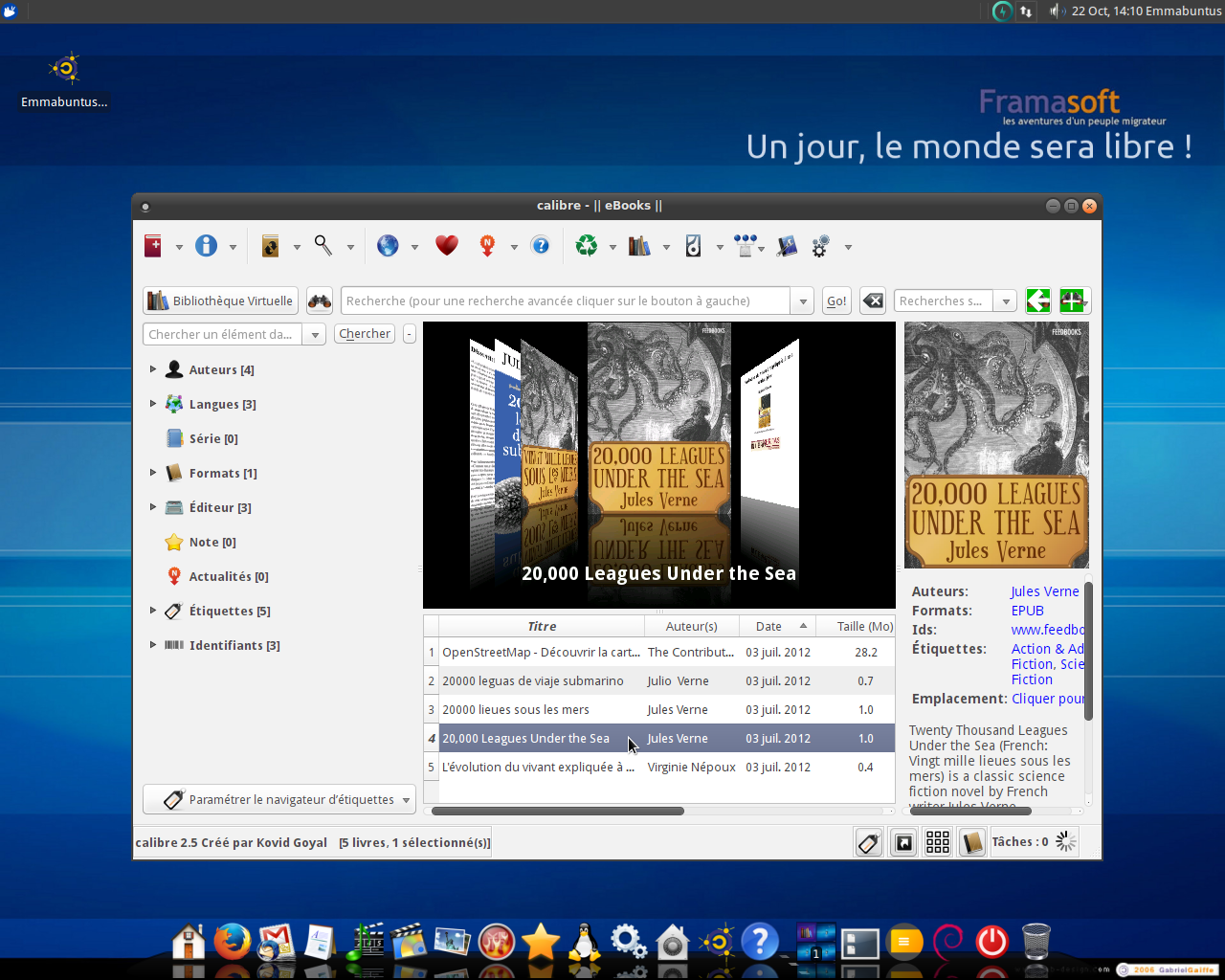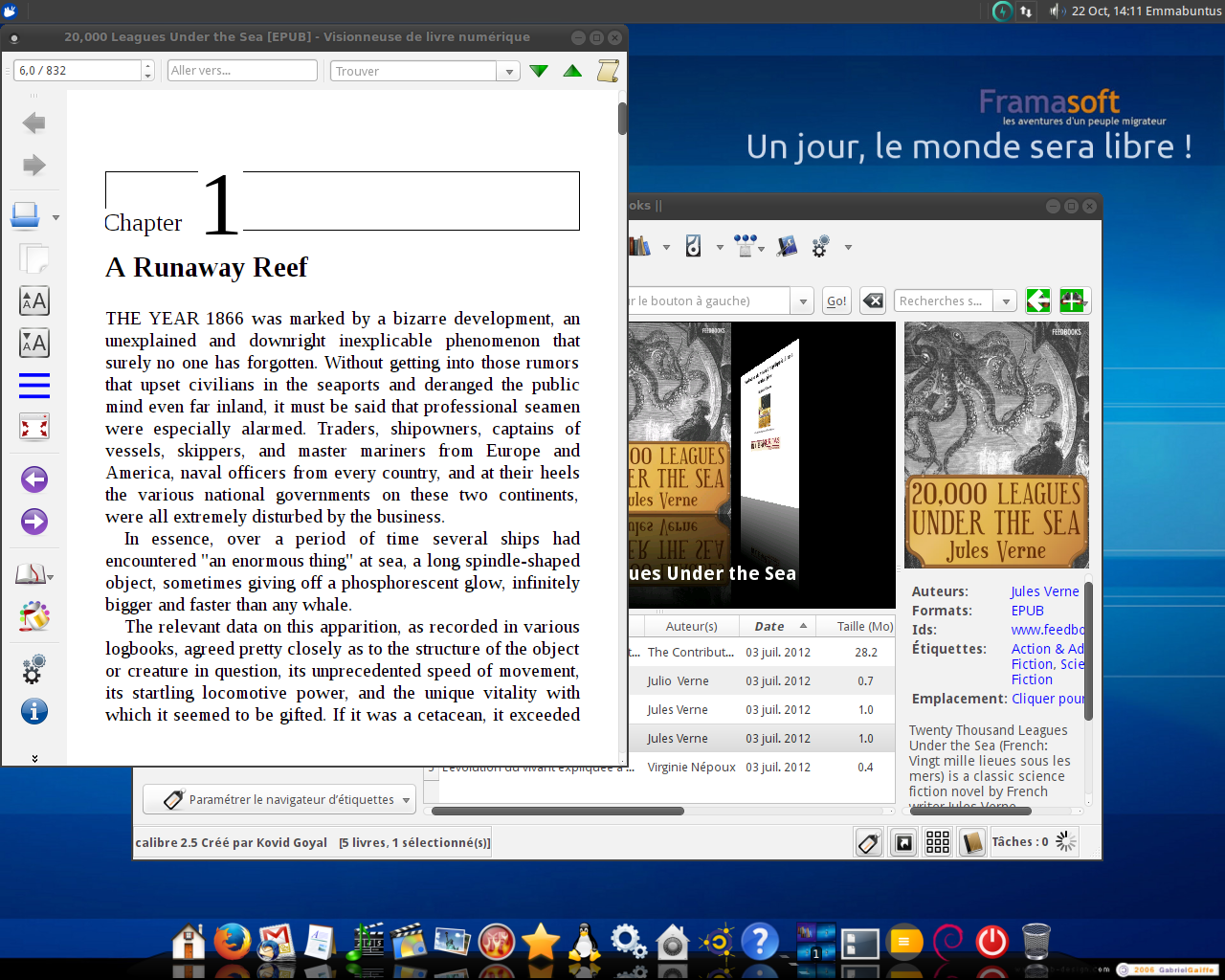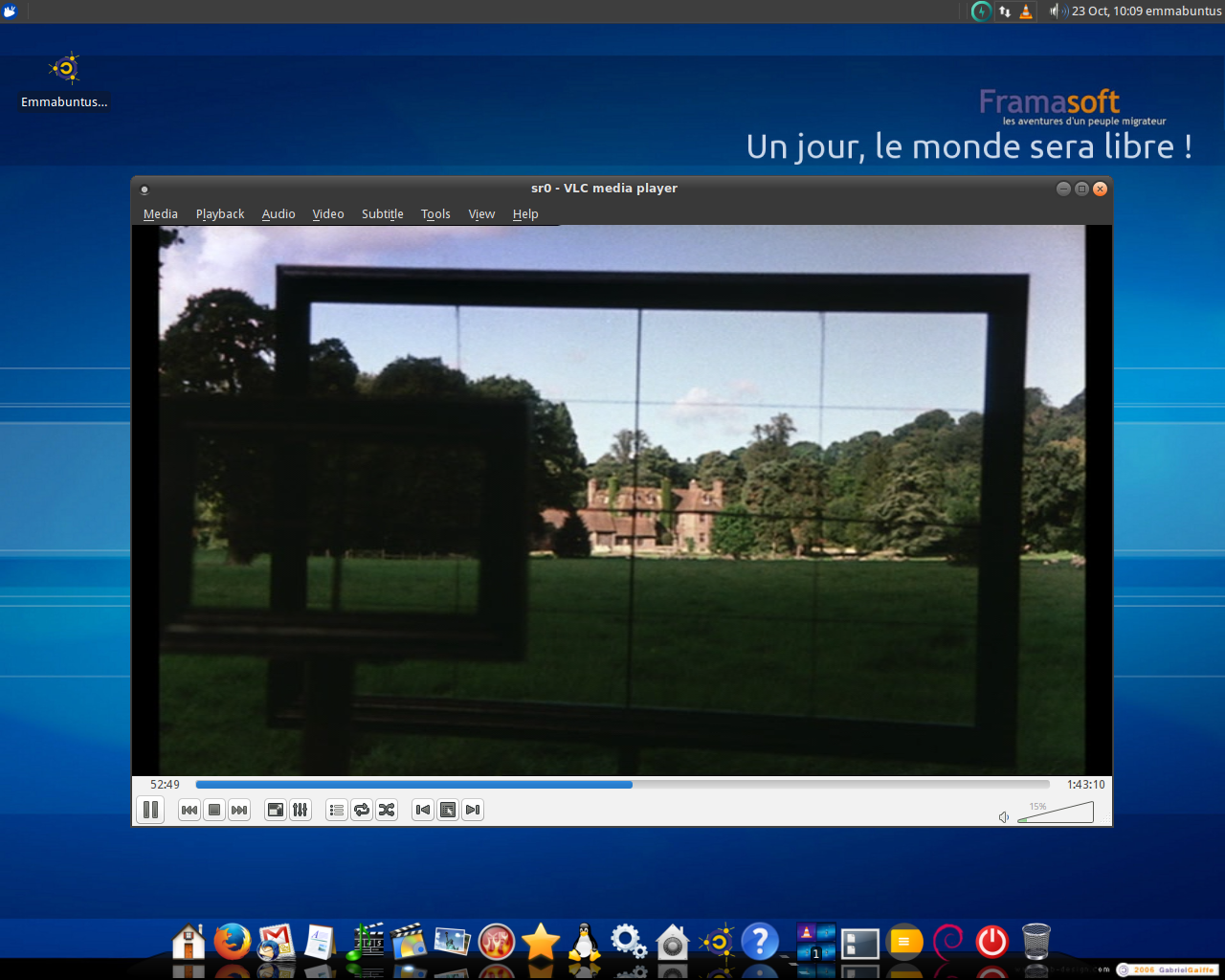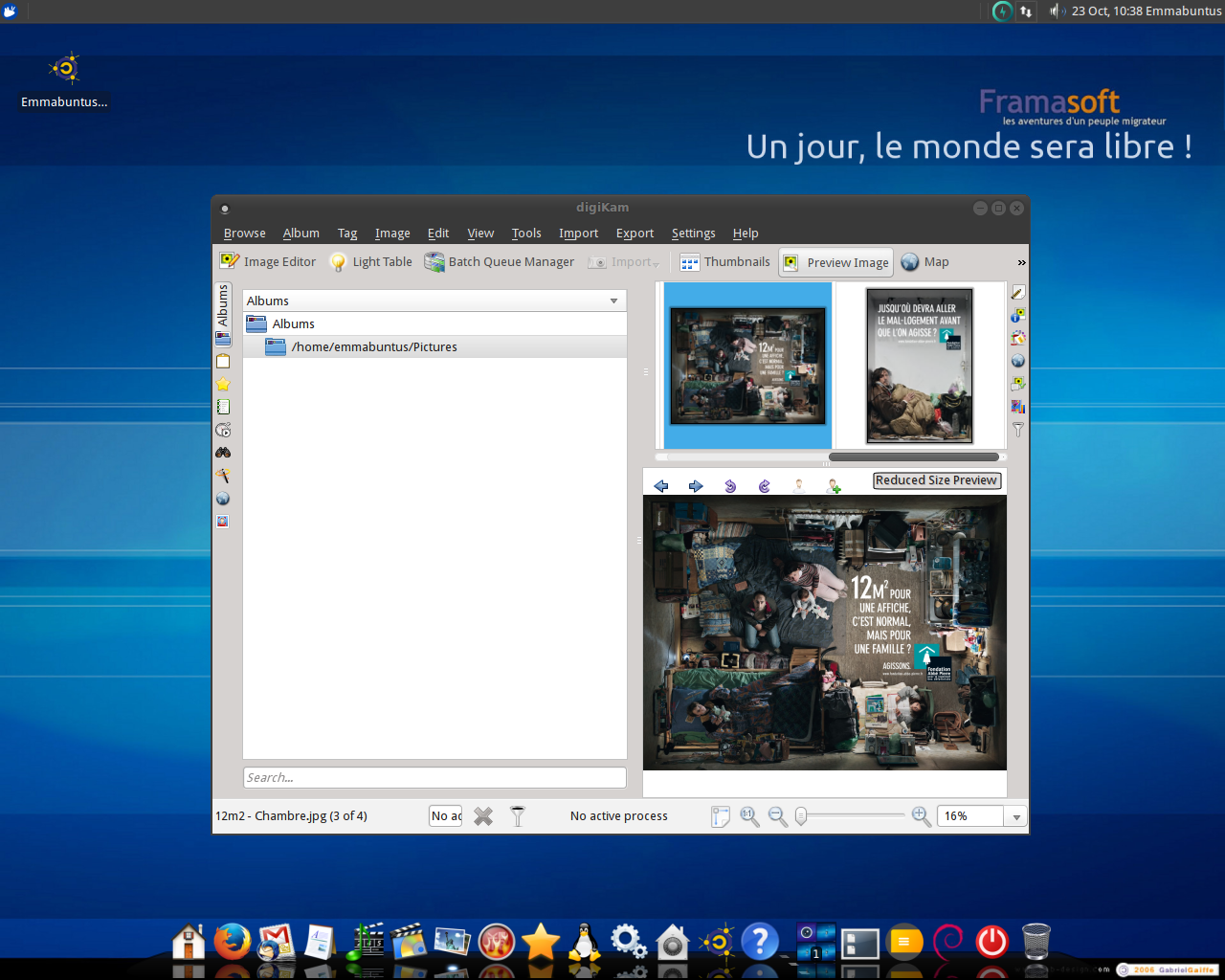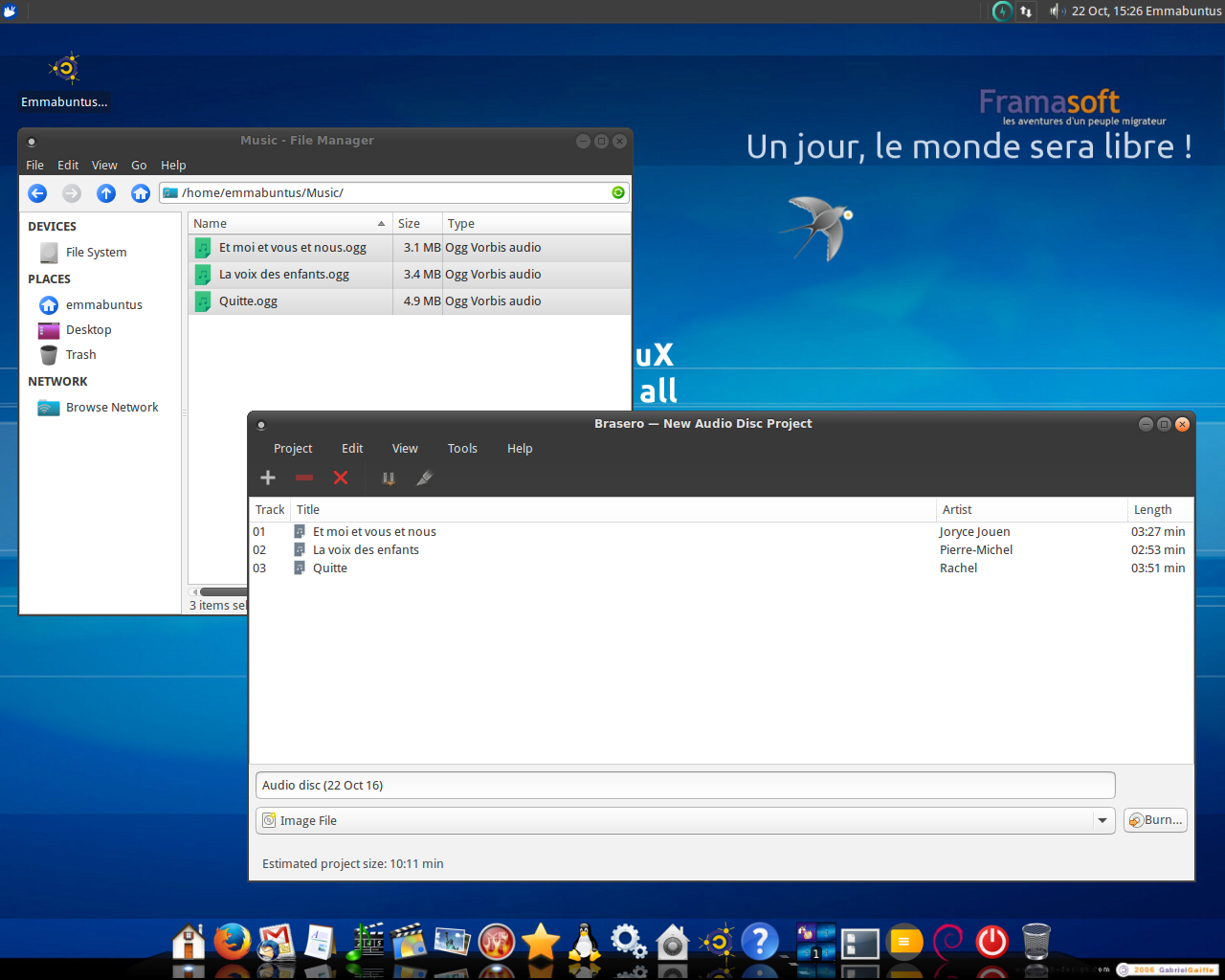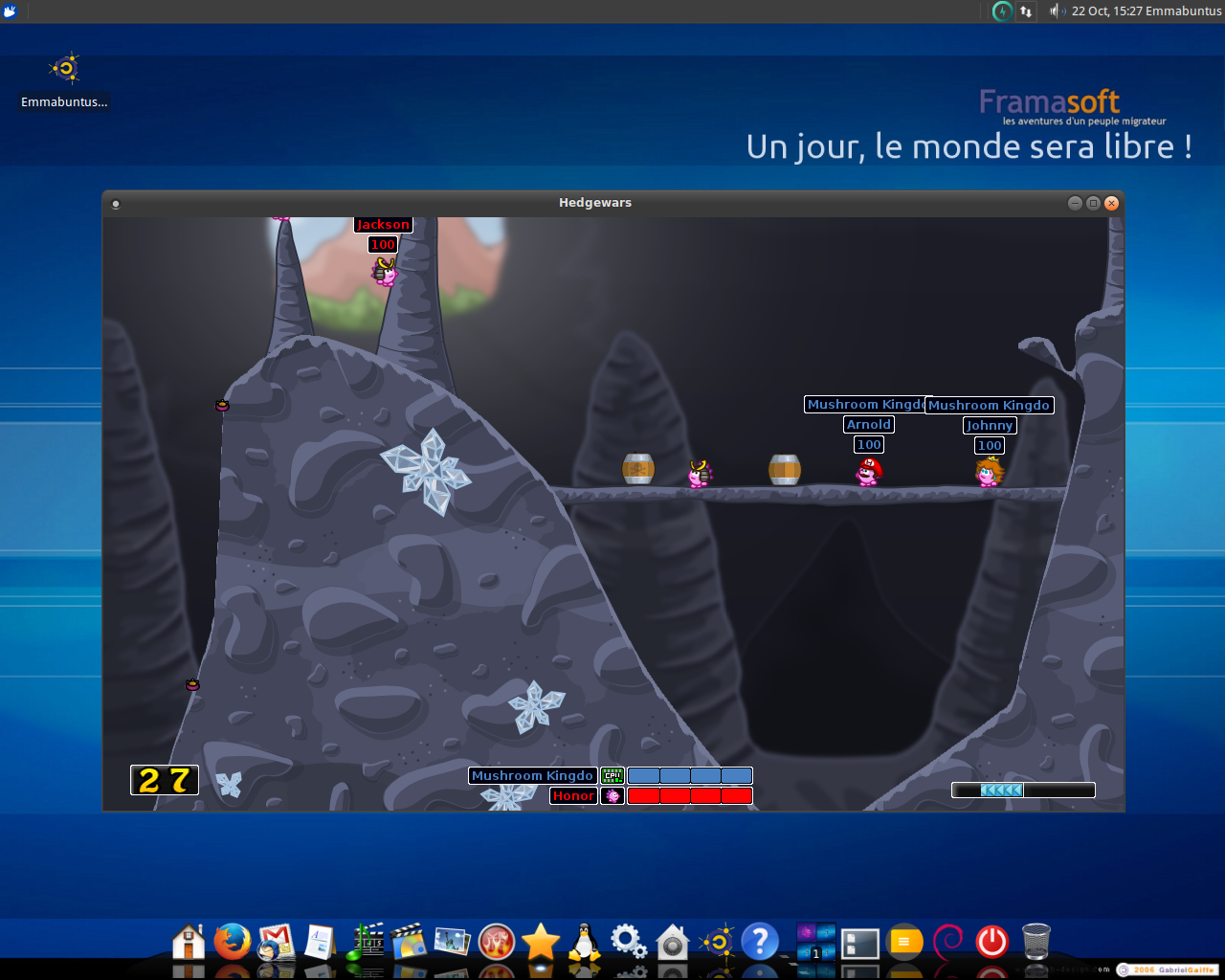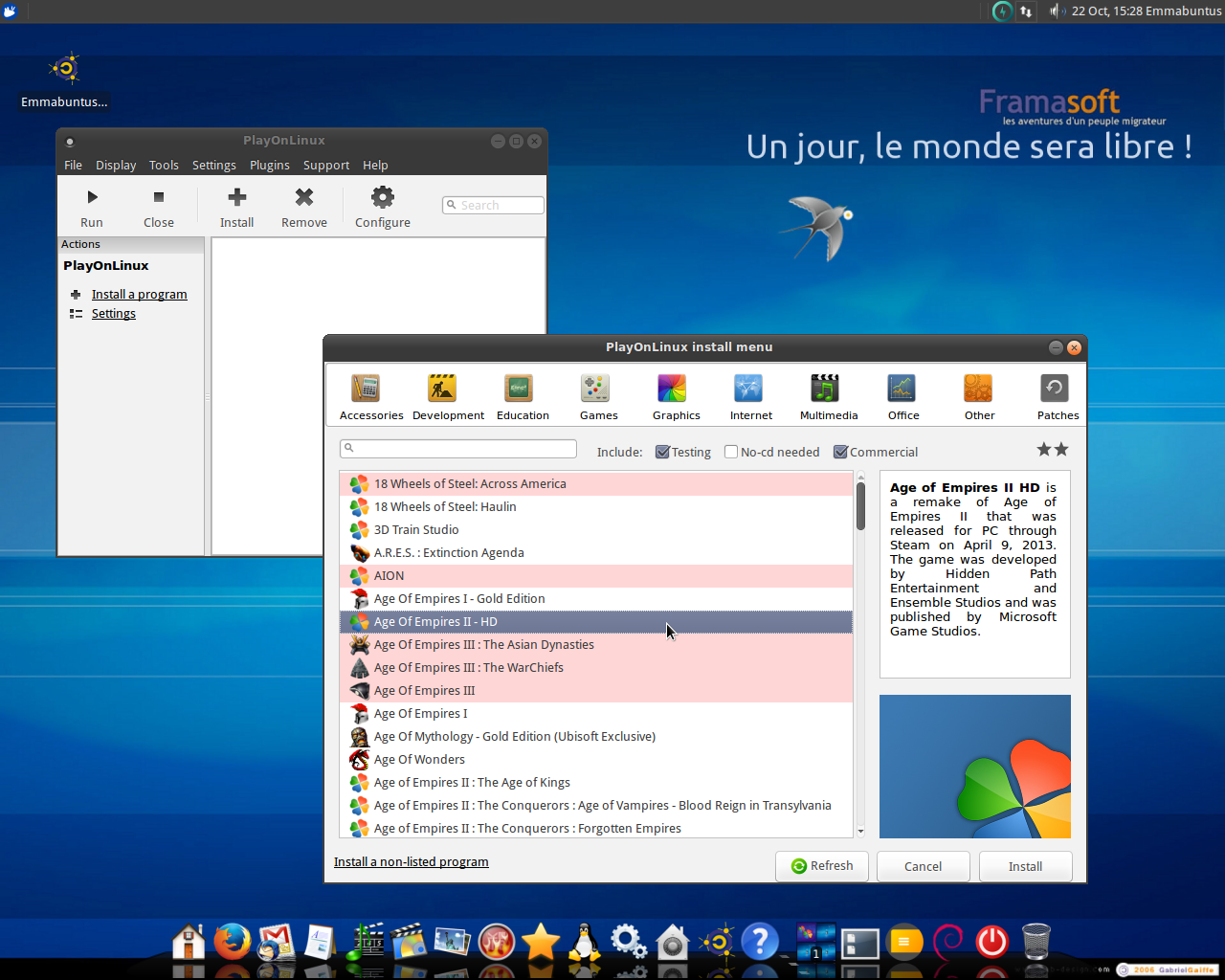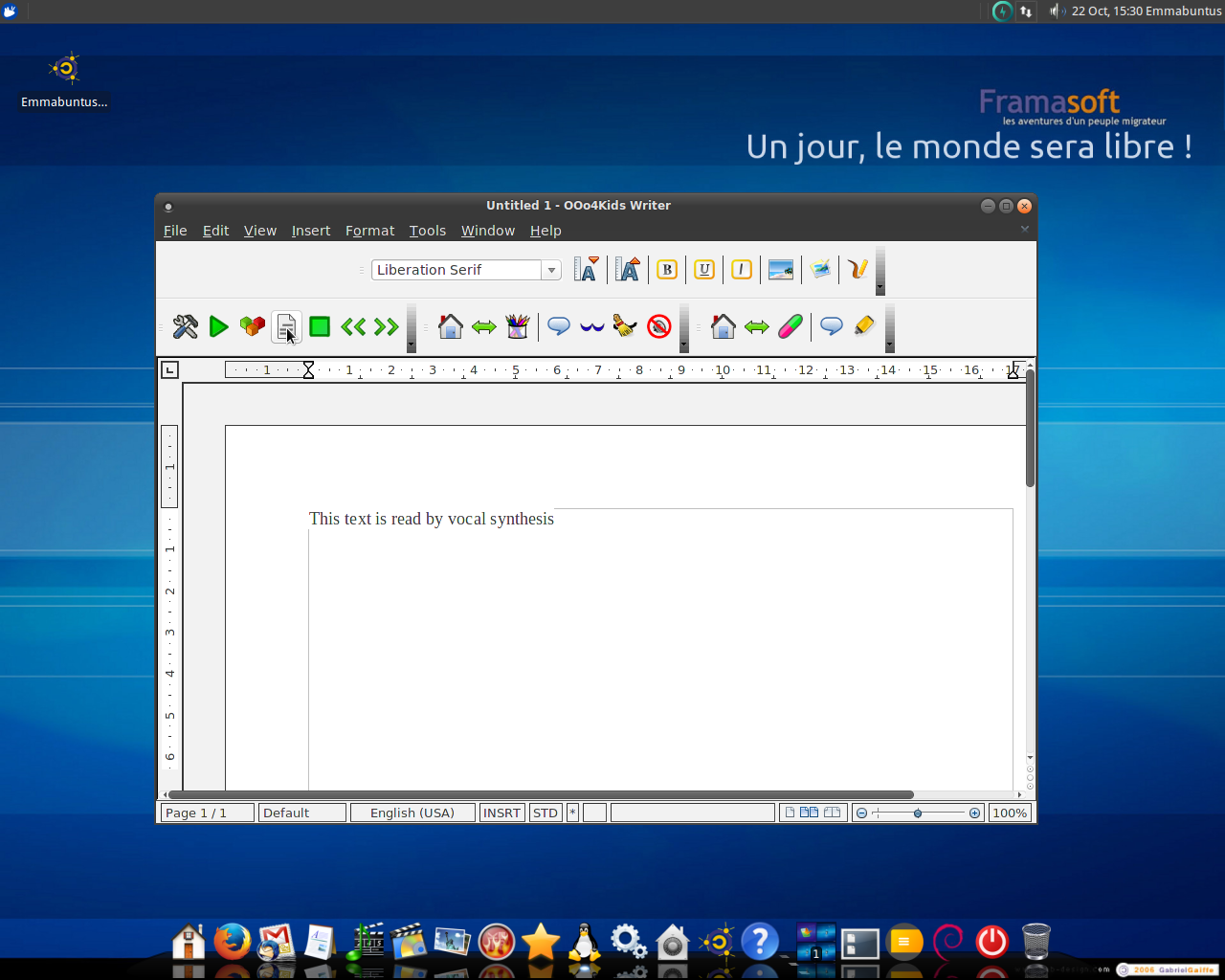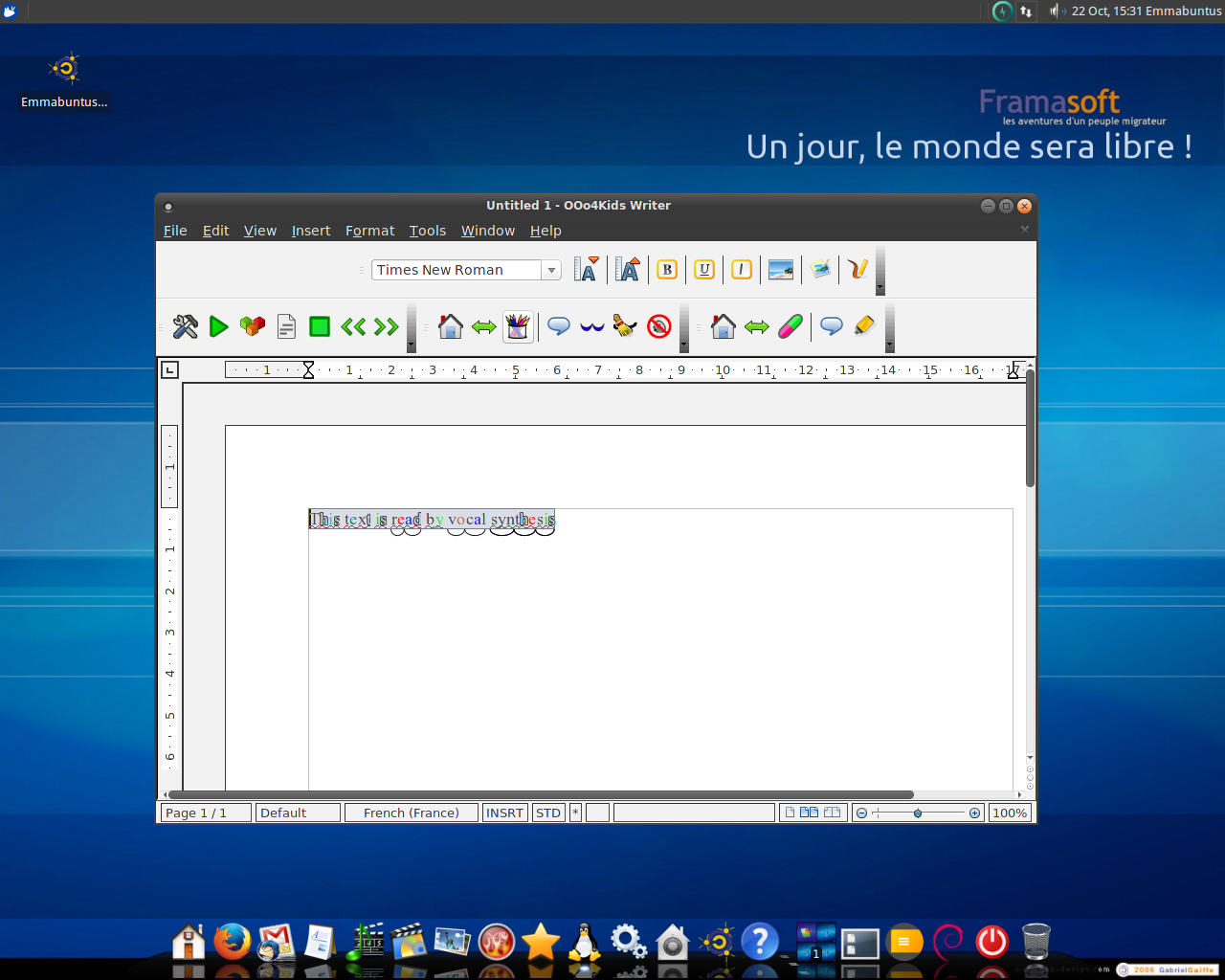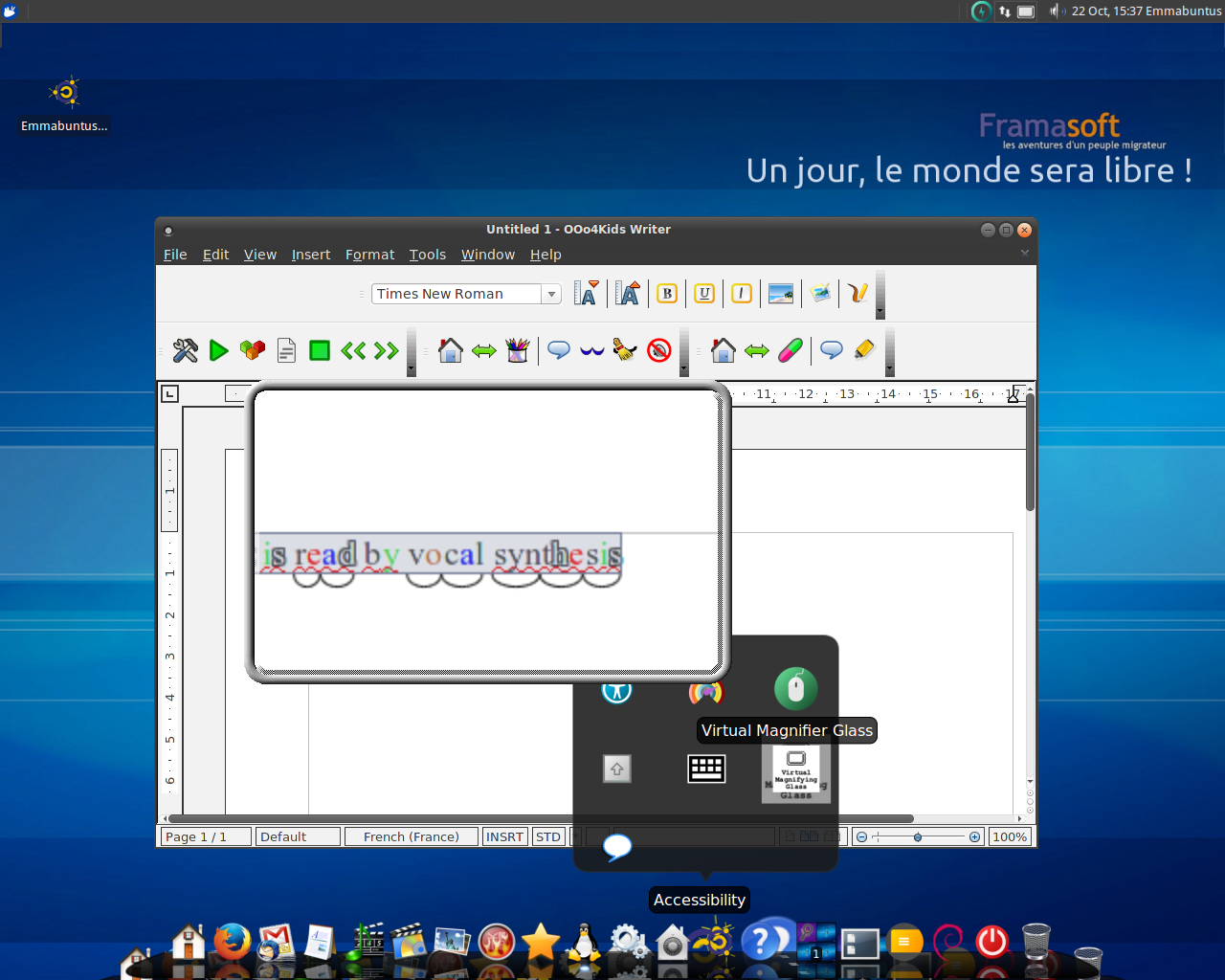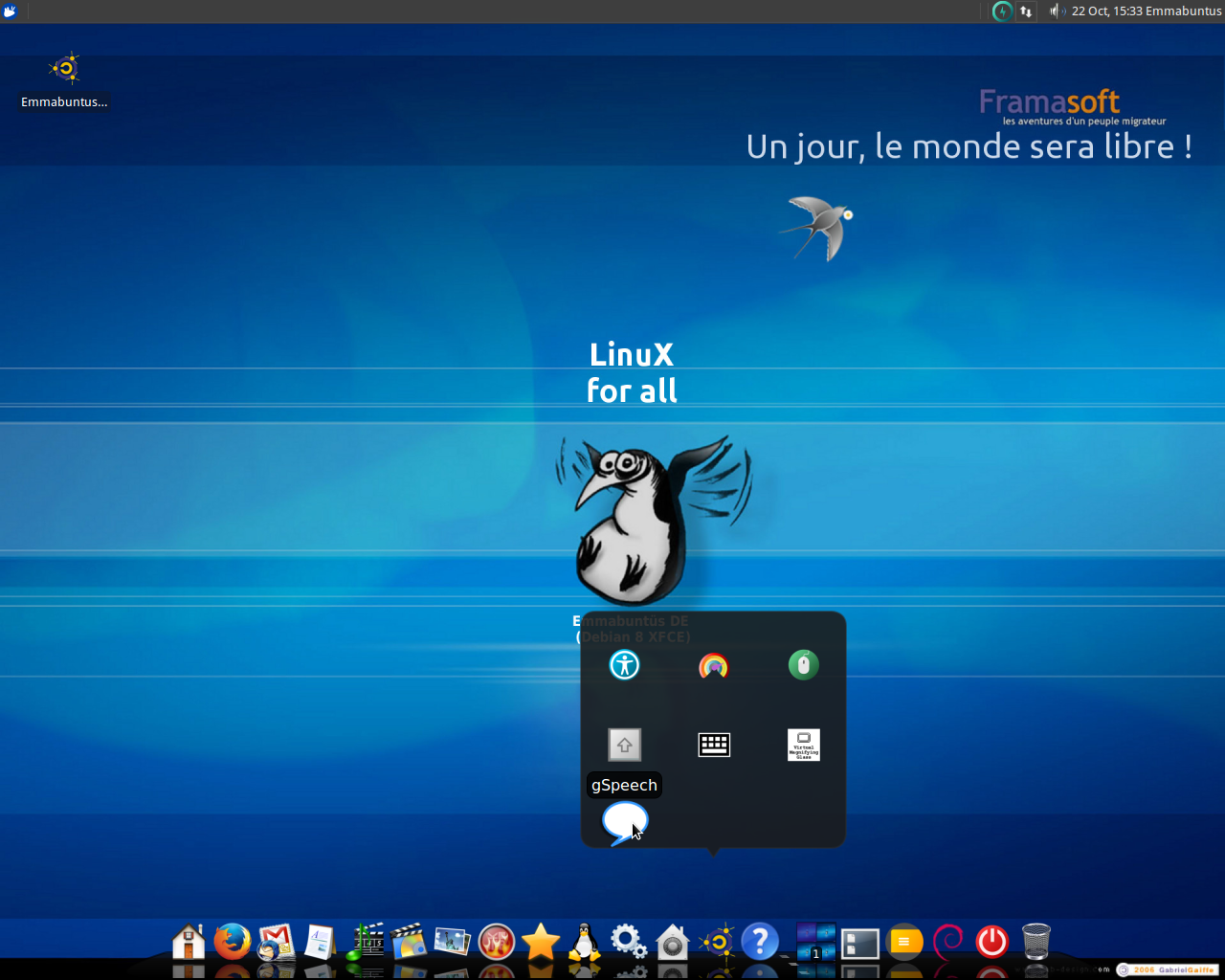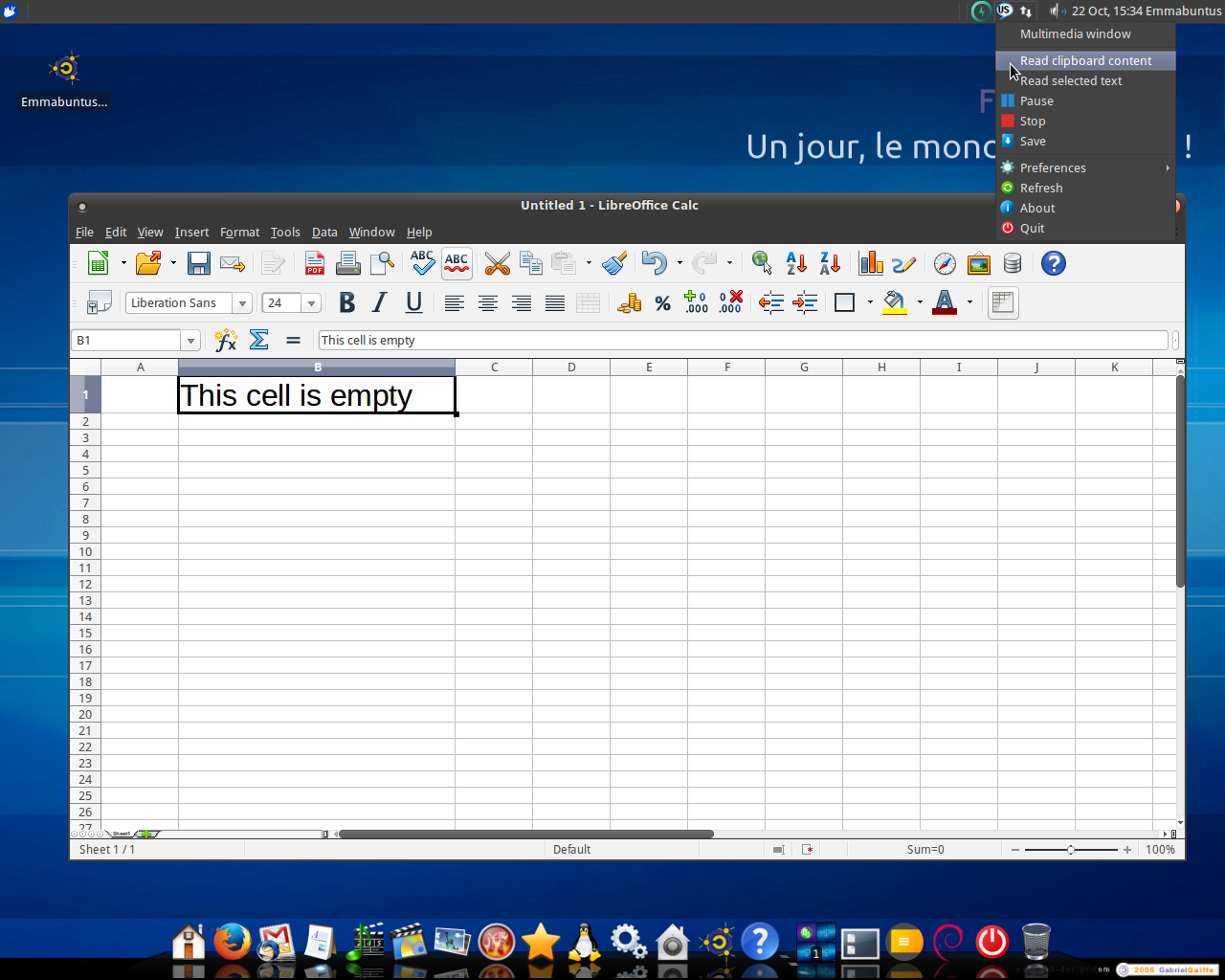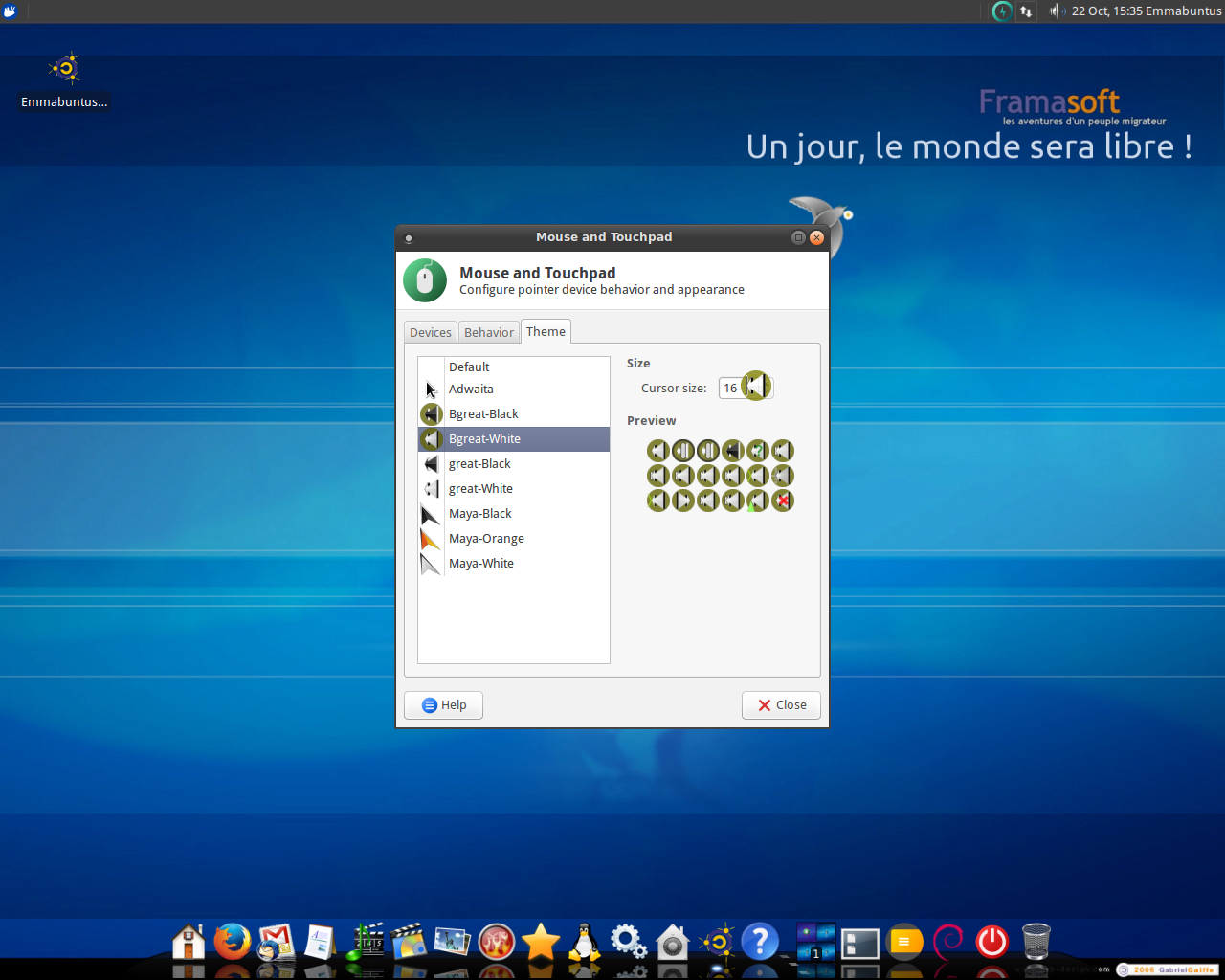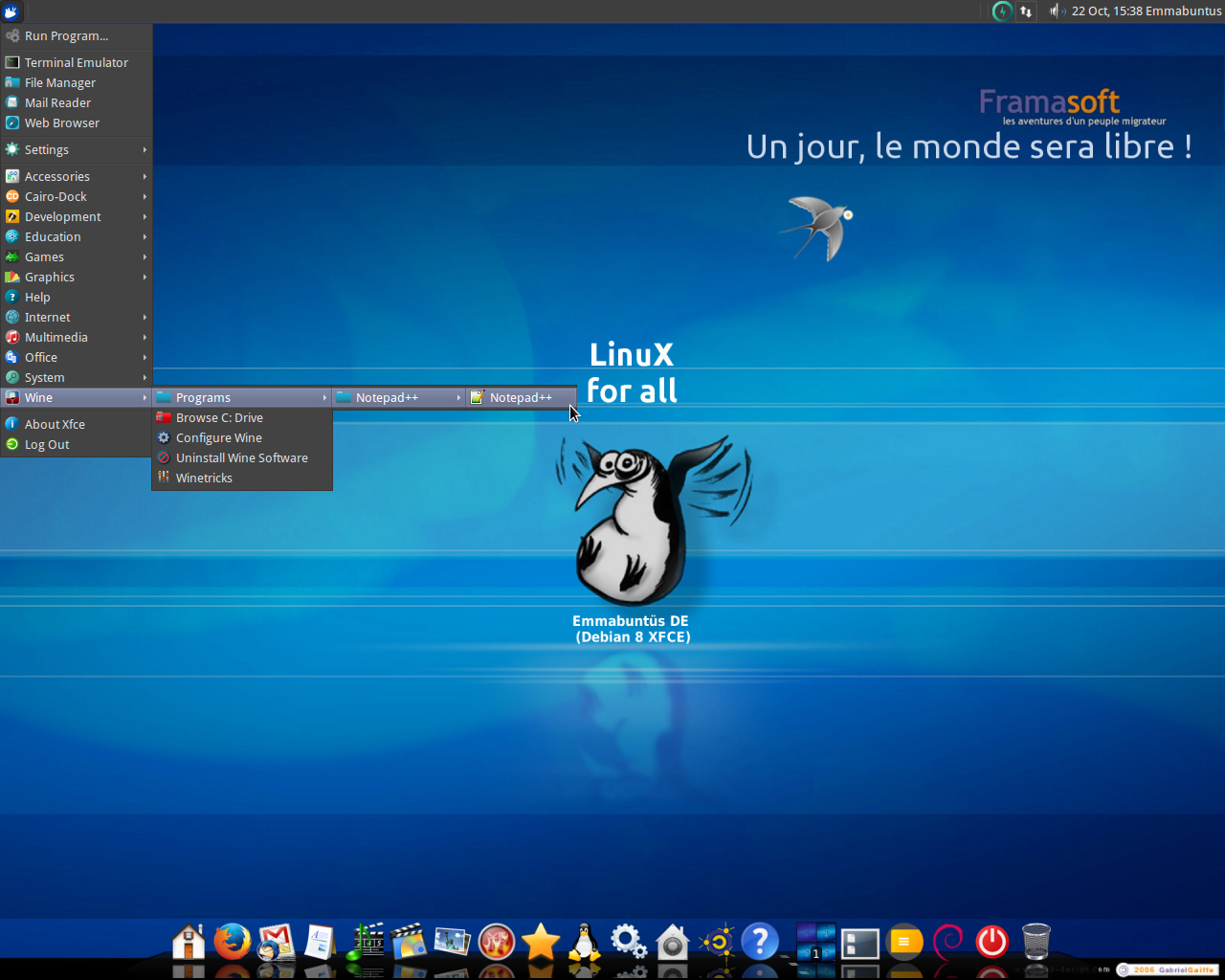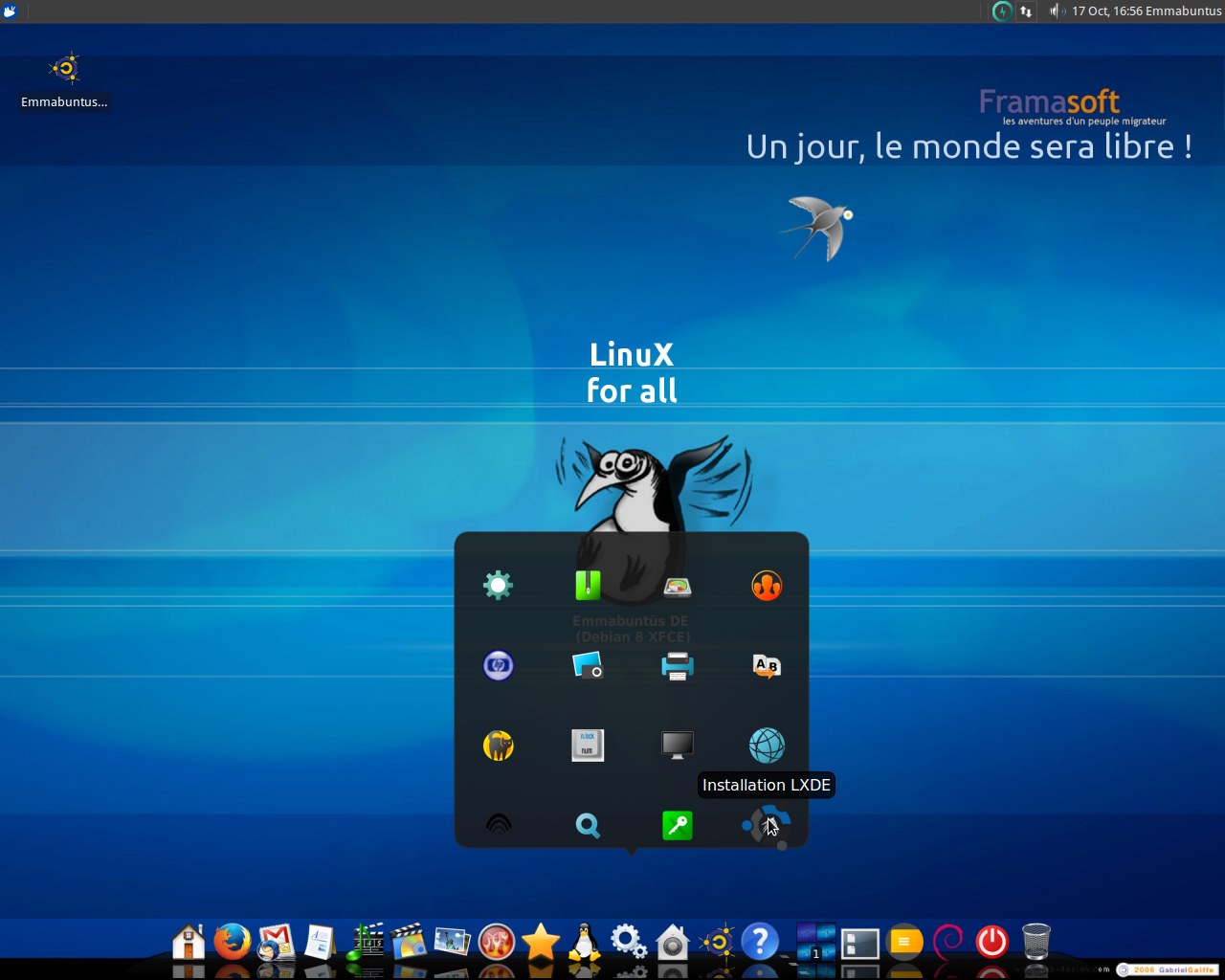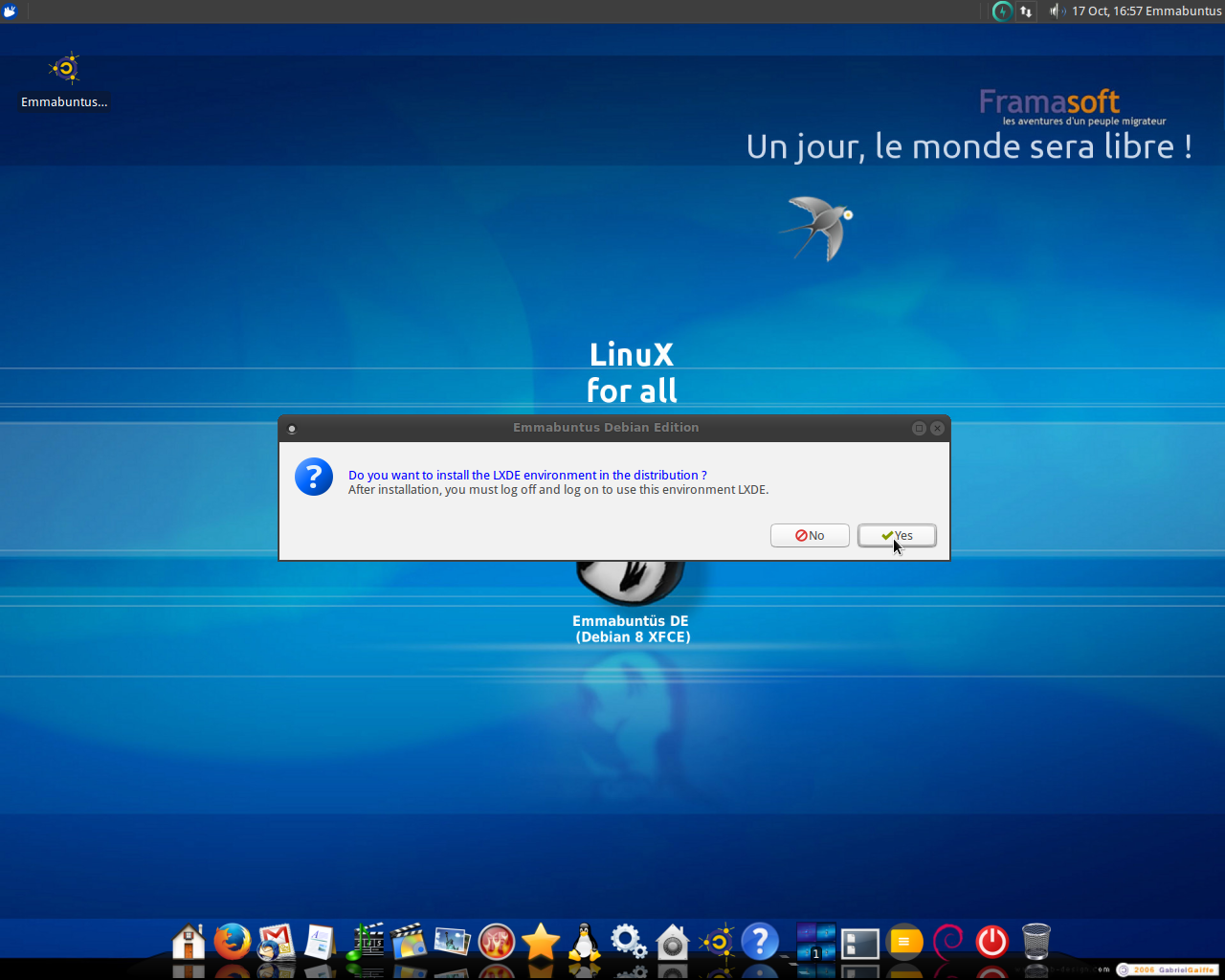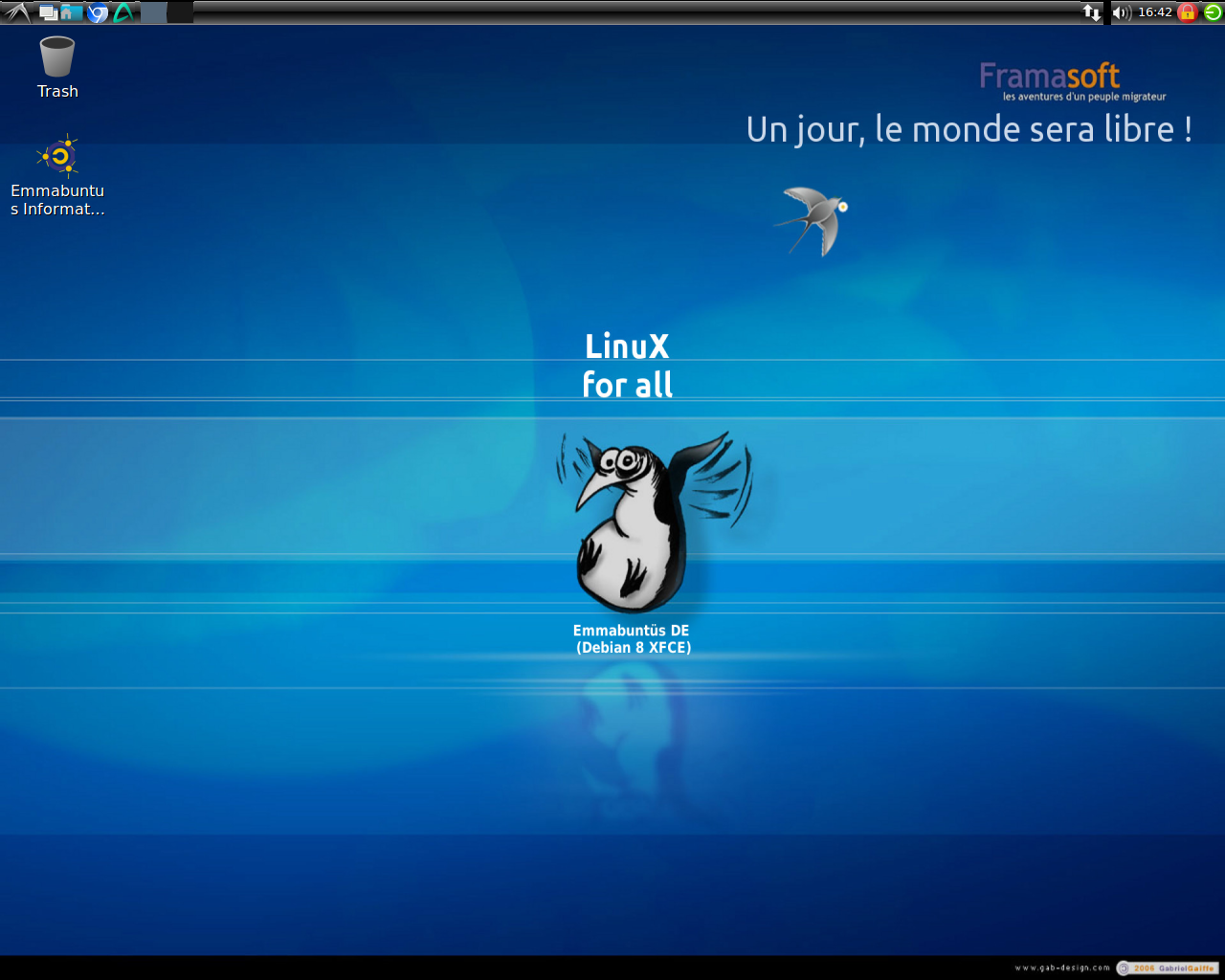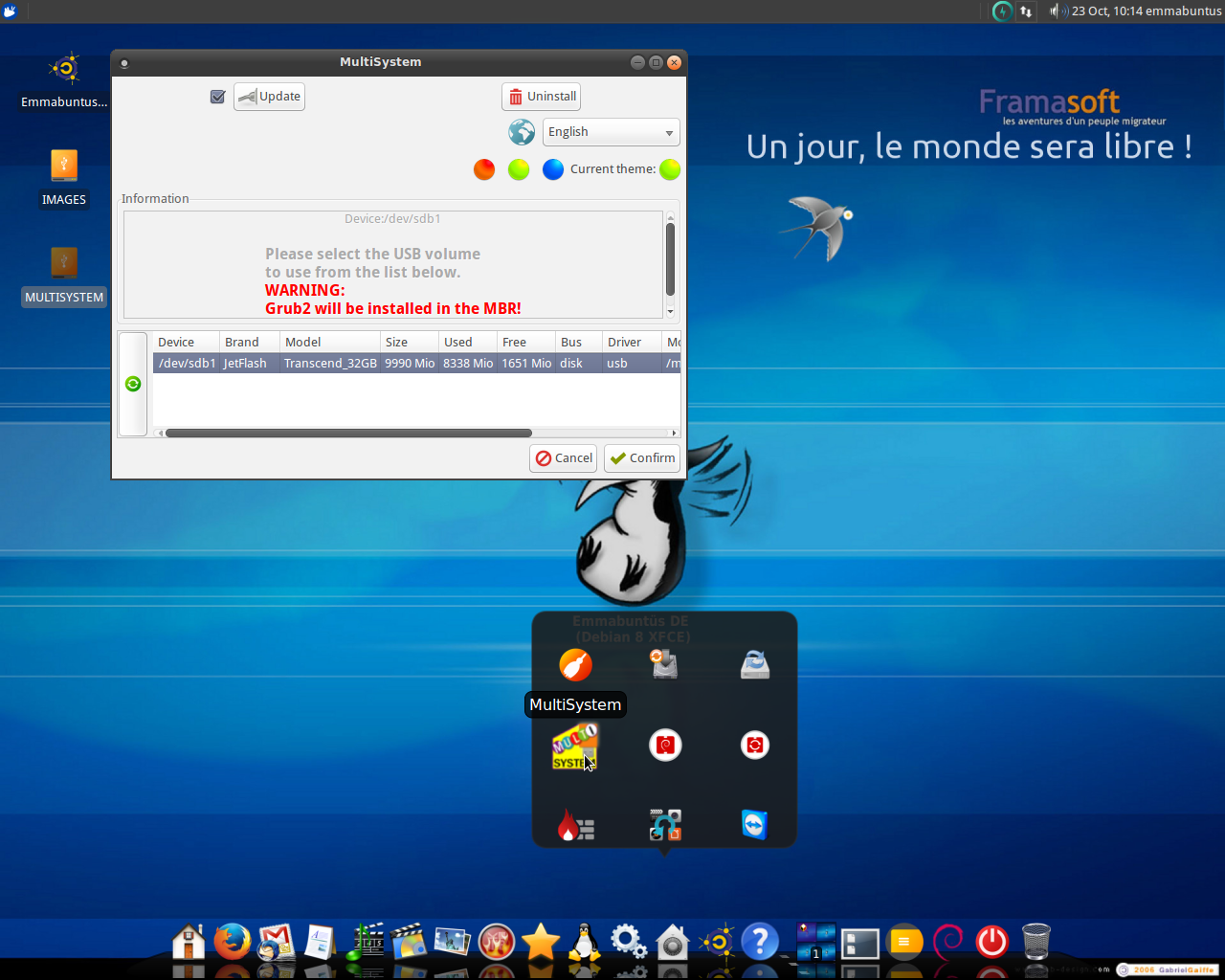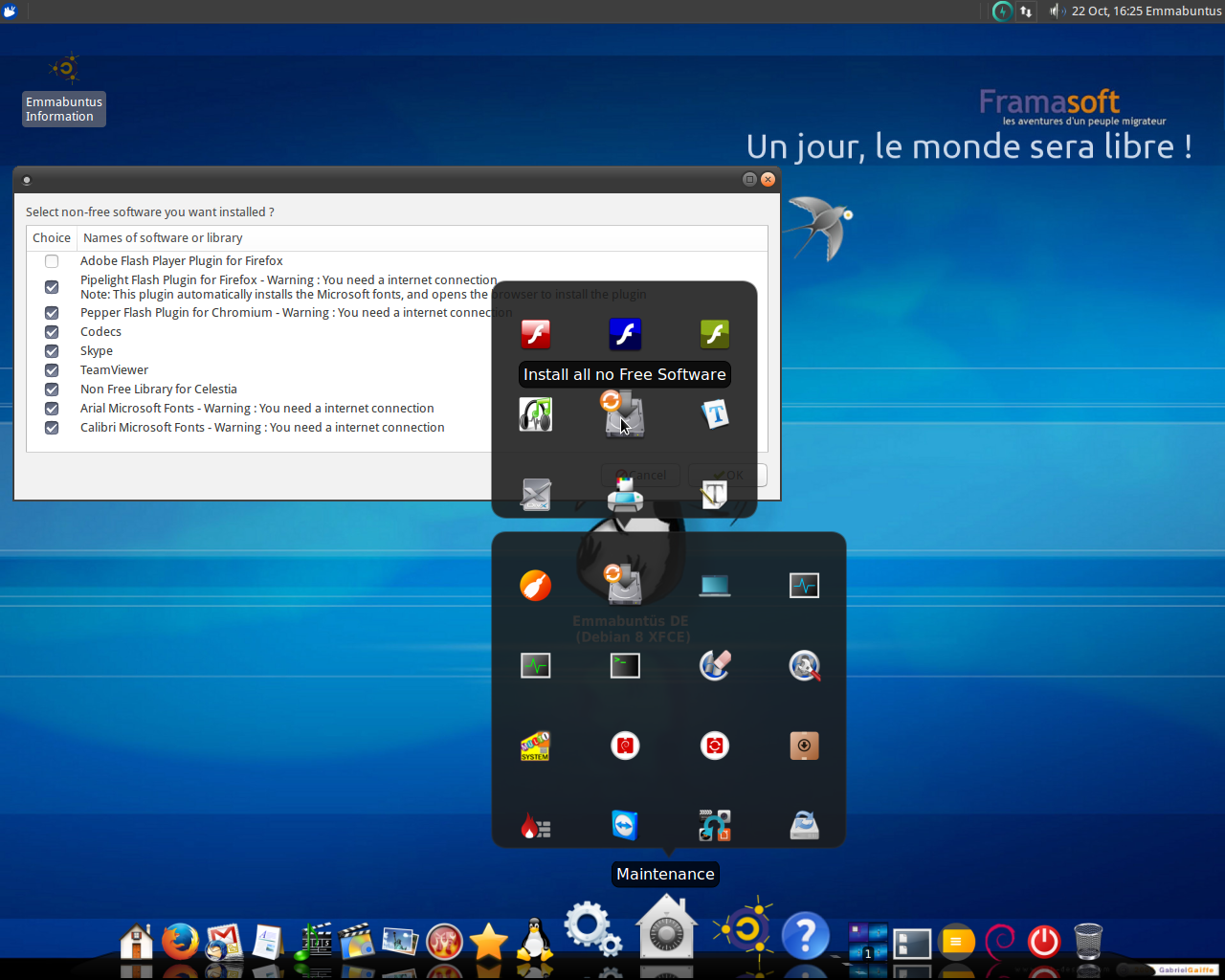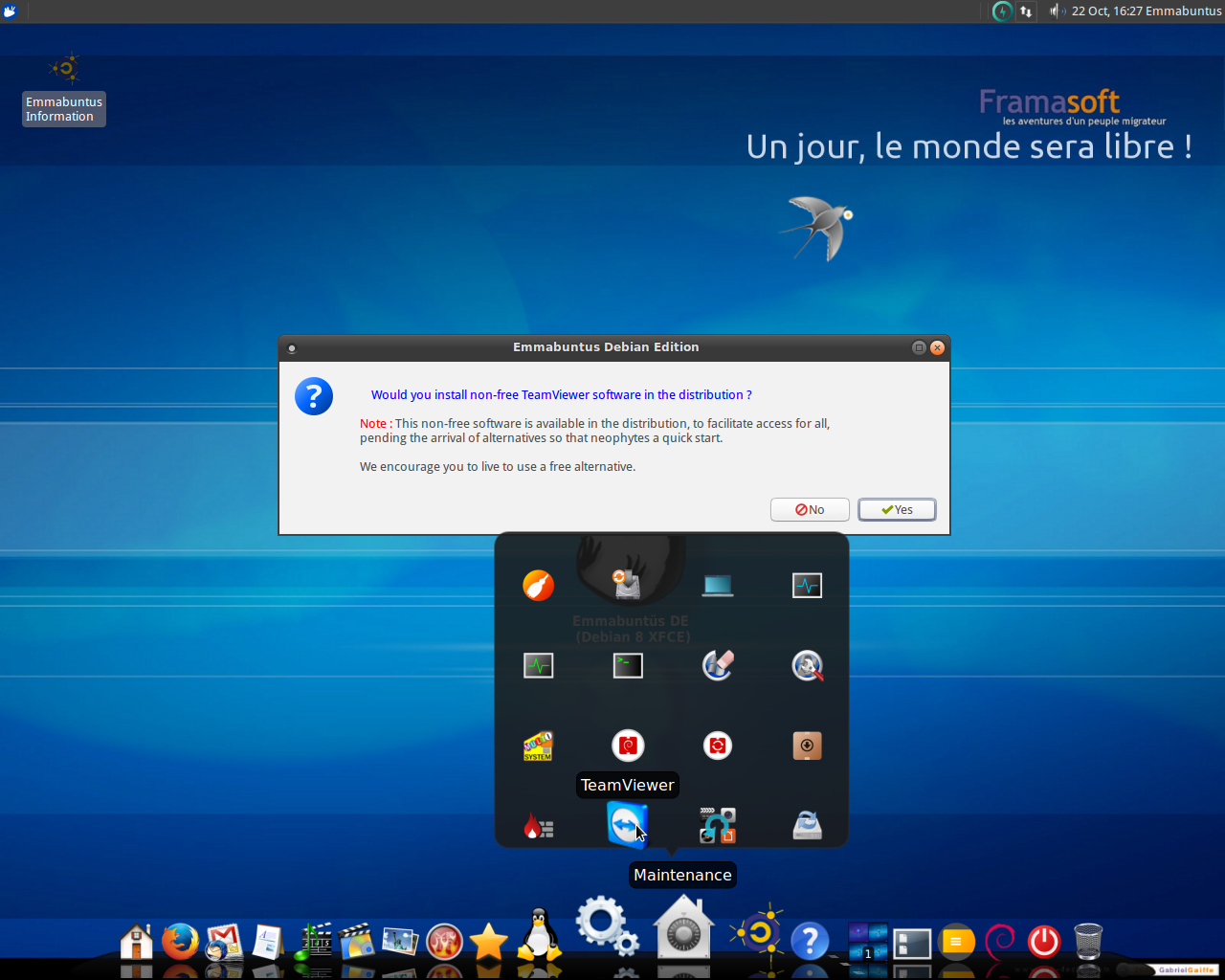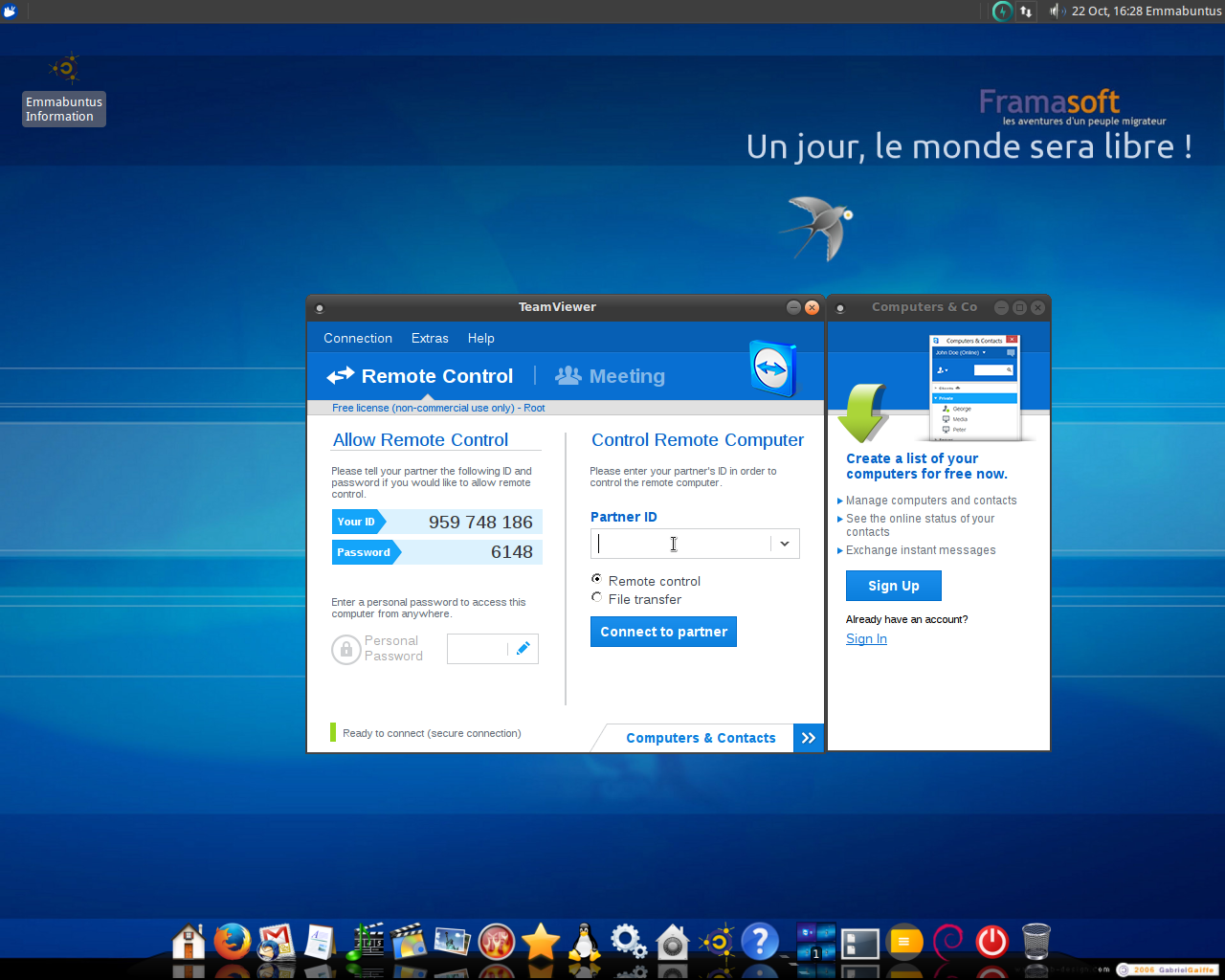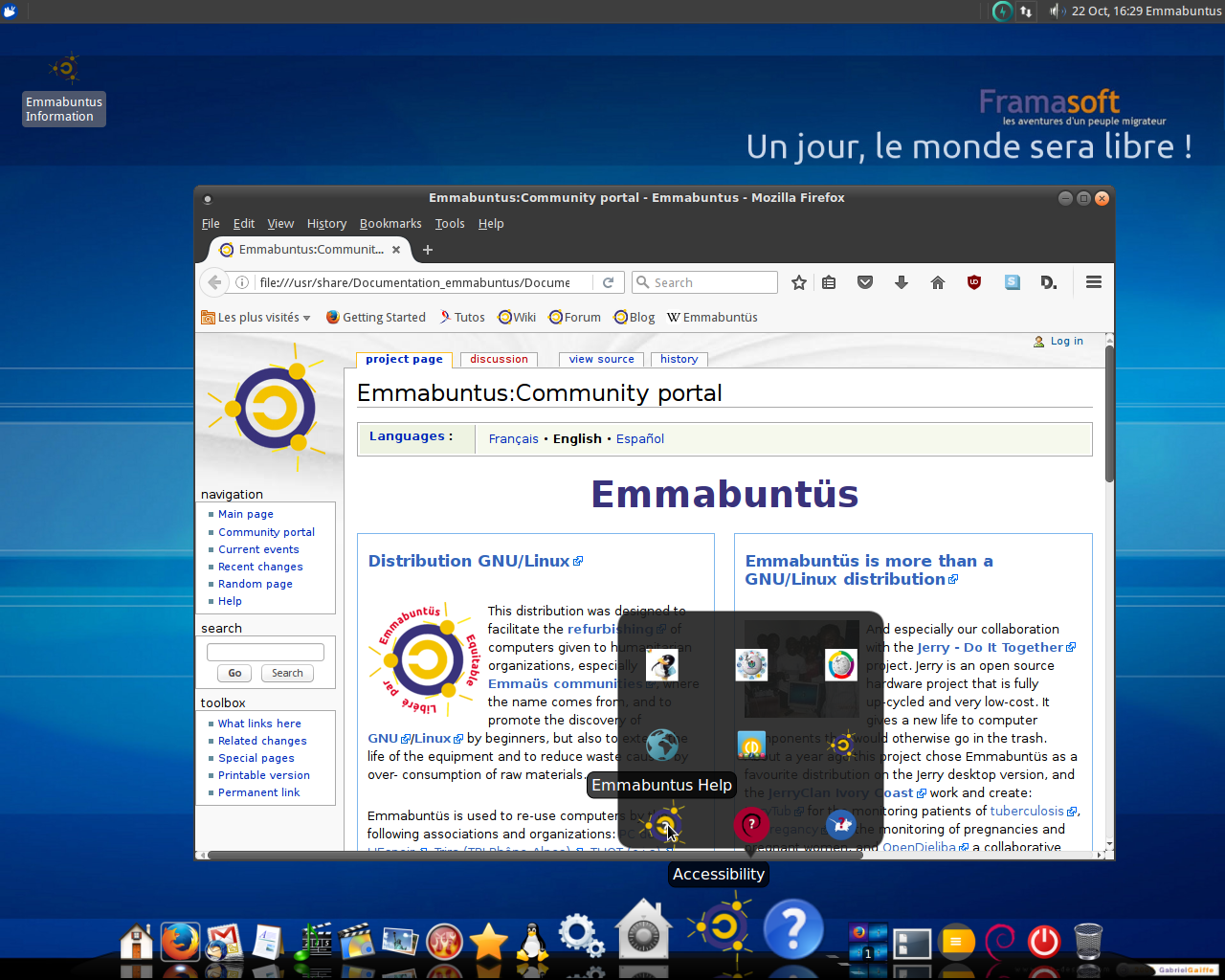I. Emmabuntüs Debian Edition Distribution▲
The various GNU/Linux Emmabuntüs distributions were first designed to ease the refurbishing of computers given to humanitarian associations in general, and to the Emmaüs communities in particular (hence the name of this distribution). The second goal was to help the beginners in the discovery of the GNU/Linux world, and the third one was to extend the lifetime of aging pieces of hardware in order to limit the overconsumption of raw materials (see Note 1).
The Emmabuntüs Debian Edition distribution is based on Debian 8 XFCE, applying the same basic concepts, but being more lightweight it can be installed on rather old computers and with less performing hardware. This distribution also includes the complementary LXDE/OpenBox environment to extend its computer refurbishing capabilities.
II. Project goal▲
The action of the Emmabuntüs Collective goes beyond the assembly of a Gnu/Linux distribution. What we also aim at is to put in place structures supporting humanitarian associations in their computer reconditioning tasks and encourage other persons to follow our step in order to fight against the three following scourges:
- The poverty among certain segments of the population, by providing new revenue sources to the humanitarian associations thanks to the sales of these machines.
- The “digital gap” in France and in the World, and more specifically in Africa, through the release of a distribution enriched with Free Data.
- The waste induced by the overconsumption of raw materials, by increasing the lifetime of electronic components.
III. Cooperation▲
Emmabuntüs is not only a GNU/Linux distribution, but also a collective working within some Emmaüs communities for the reuse of computers donated to them. Hence the collaboration with associations like Les Amis de la Terre, Festival de la Récup, Les PC de L'Espoir, Trira (TRI Rhône-Alpes), THOT (c.i.s) (With THOT for a 2.0 solidarity), Eisenia, and e-nexus.
The collective cooperate also with associations promoting the Free Software like Montpellibre, Perpinux, Gard-Linux, Infothema, l'EPN de Durbuy (Belgium), and the History Society Saint-George & Dalayrac for the Free Culture advancement.
Since August 2012, a close cooperation exists between the two projects Jerry - Do It Together and Emmabuntüs. Jerry is an open source computer assembled inside a plastic can with salvaged electronic components. It gives a new life to computer components which otherwise will end up in the trash. This cooperation was extended when JerryClan Ivory Coast started to use the distribution for their medical aid: JerryTub for the monitoring of tuberculosis patient, m-Pregancy for monitoring the pregnant woman, Môh Ni Bah for birth declaration in remote rural territories. and OpenDjeliba a cooperative platform for sharing citizen information through the usage of basic portable phones. This project received in 2014 the first price of the Forum International francophone Jeunesse & emplois verts in Nigeria.
The project GBATA is a mobile platform for sharing real estate informations using SMS communications. In July 2015 this project was the winner of the mobile application category during the « Jeunes Talents TIC et Contenu local 2015 » contest in Ivory Coast.
The Jerry Clan Ivory Coast in Bouaké city put in place a system for monitoring tuberculosis patient using a Jerry computer under Emmabuntüs and SMS sent by portable phones.
Photo credit : CC-BY-SA Jerry Clan Ivory Coast
Emmabuntüs is also used in the frame of the JerryCyber project developed by Ayiyikoh Incubator (Jerry and the women). This project consists in giving the Fablab members and all the public access to information technology and Internet. The Ayiyikoh Incubator team won the best application prize during the Africa Web Festival 2015 for the GBAME project which was realized with a Jerry under Emmabuntüs
This collaboration gave birth to several others with the JerryClan in Ivory Coast, Togo, Chad, Benin and Senegal and the new Cameroon Emmabuntüs collective.
Since summer 2013, the Montpel'libre (The dragonfly of Liberty, from Equality to Fraternity) association helps the Montpellier Emmaüs community by proposing pre-sales presentations. The aim of this activity is to present Emmabuntüs to the potential customers who want to buy a computer and to help them making up their mind.
But the Montpel'libre support does not stop here. The customer not only takes the computer with him, but also the coordinate of the association in order to contact them in case of problems. As of today the team is composed by Pascal, Quentin, Cellou, Romain, Nicolas and Cédric who assume a permanence the second Saturday of each month.
Presentation of Emmabuntüs and the free software by Montpel'libre, on December 19 2015,
in the Emmaüs community premises of Saint-Aunès (Montpellier)
Photo credit: Montpel'libre
Since end of 2015, we were working with a couple of associations in Normandy : Ailleurs-Solidaires (Emmabuntüs, the Linux for « Ailleurs Solidaires ») and CaLviX. Emmabuntüs has been installed on used laptops, which were then given in the Nepal to the Akashganga International Academy (school based in Kathmandu, with 250 children), and to the DSA Disabled Service Association (center for 55 disabled - blind, deaf and dumb, physically impaired - children and all of them are extremely poor). The results are really outstanding and Emmabuntüs was enthusiastically adopted by the children.
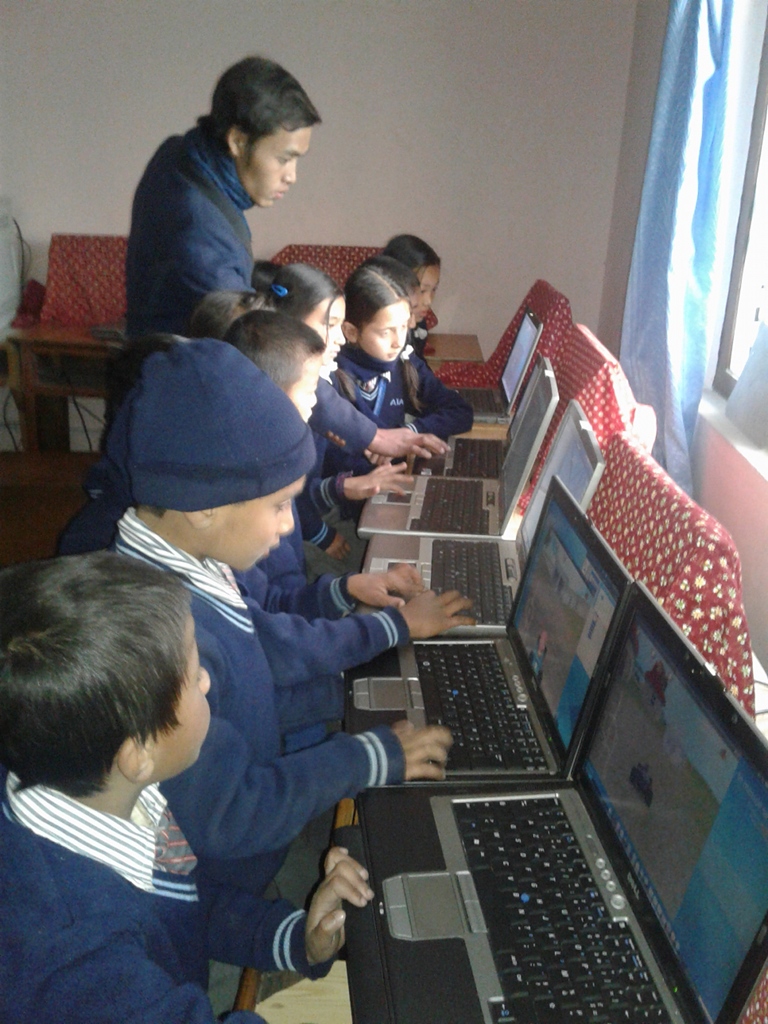
Since March 2016, we partner with the YovoTogo and JUMP Lab'Orione (The march of the YovoTogo children toward the digital age) associations to help them to install and use Emmabuntüs on 46 computers deployed in two computer rooms of the Don Orione Center, and a third one in the Nano college.
On top of this we also have the computer room of Nayéga implemented by the Rotary-Club de Fleurus Belgium, and in October 2016 the North Savannah region of Togo will be equipped by 7 computer rooms including a total of 150 computers, running the GNU/Linux Emmabuntüs system enriched by some free culture data : free literature (format ePub), Vikidia, and a complete snapshot of the Wikipedia encyclopedia.
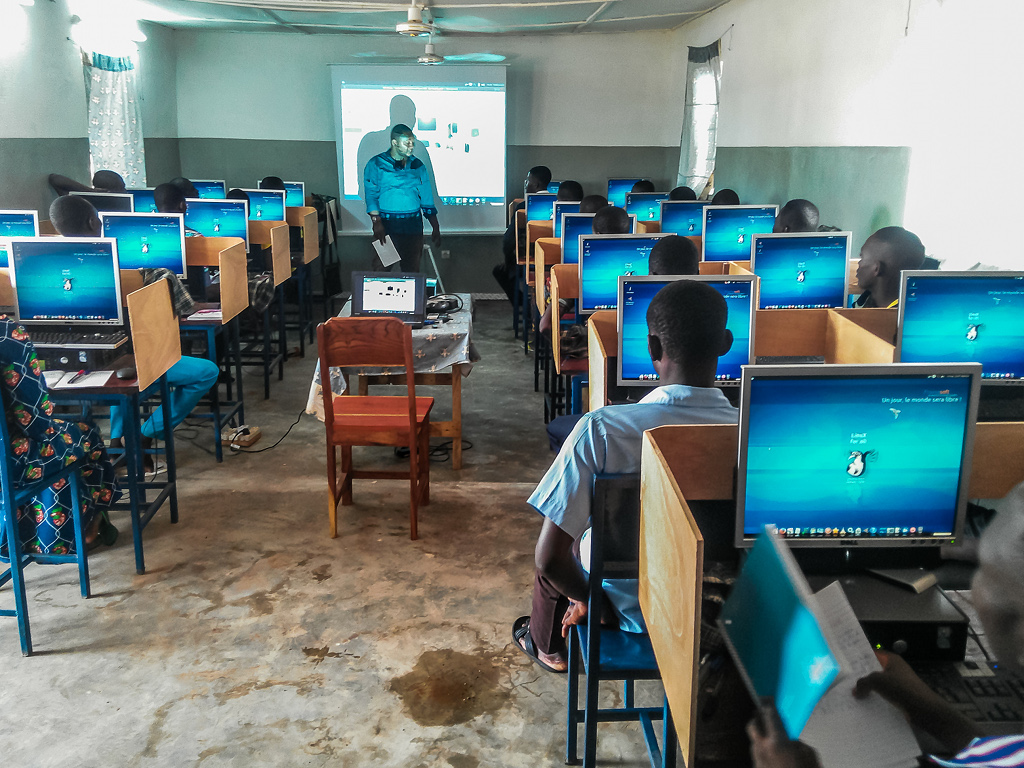
With Hélène, Jacquot, Jack and Robert from our collective, we are continue also to equip nursery schools in the Parisian area, and as soon as September 2016 we will complete the installations of the 5th and 6th schools.
IV. Requirements▲
For a comfortable usage of Emmabuntüs Debian Edition, the reconditioning workshops install it on computers featuring Intel Pentium D @3.00 GHz or Dual Core processors, with at least 1 GB of RAM and 80 GB on hard disk.
For less powerful computers like portables with Pentium M, or desktop computers with Pentium 4, 4 HT with 512/768 MB of RAM and 40 GB of hard disk, we strongly suggest to install Emmabuntüs DE version 586 or HandyLinux which are compatible with non-PAE processors.
The machine originally running under Windows 95, 98, 2000 or NT do not have the performance required to run the software currently available, and it is better to use the SliTaz distribution.
Emmabuntüs Debian Edition can also run on LXDE with a RAM footprint of 126 MB at startup time. See the installation of LXDE under Emmabuntüs DE.
V. Features▲
This list summarizes the Emmabuntüs key features.
- Distributions based on Ubuntu LTS (10.04, 12.04, 14.04) variants, and Debian 8.
- Fast installation mode through automated scripts.
- Live mode on DVD and USB key (Multisystem, UNetbootin, USB-Creator).
- Autonomous install without Internet connection, everything is included in the distribution.
- Choice given to the end user to install - or not - the non free software packages (Flash Player, Codecs, Skype, etc.).
- More than 60 additional applications.
- Configurations of Internet browsers and LibreOffice suite.
- A dock giving an easy access to the complete set of applications.
- Seven supported languages (English, French, Spanish, Portuguese, Italian, German, Arab)
VI. Emmabuntüs Overview▲
The goal of this presentation is not to describe the whole set of software inclusive within the Emmabuntüs distribution, but rather to present an overview of this specific GNU/Linux distribution and to show that it can be used in the frame of “Digital Public Spaces” as well as nursery and elementary schools.
VI-A. Installation▲
Emmabuntüs is installed like any other Debian distributions, except the facts that you need at least 15 GB of free hard disk space, and that you do not need an Internet access to complete its installation. We even strongly suggest not to connect the computer with Internet during this process in order to ensure a seamless installation. You can then establish the Internet connection during the first reboot of the machine to finalize your installation by downloading - or not - some non-free software packages.
For more information about the different ways to install this distribution, you can read this installation tutorial which will help you to avoid some of the installation pitfalls.
The full set of our tutorials is available on line at Developpez.com.
VI-A-1. Launching the installation from a DVD▲
When you start the installation from a DVD, you will be given the opportunity to chose your preferred language, either for a Live-Mode session or for the full installation.
Select the Intall line :
VI-A-2. First reboot after install▲
Enter your account information in the session login screen :
Selection of the Xfce Classic menu (suitable for old computers) or Whisker menu (more modern indeed, but also consuming more RAM):
This menu selection (Classic / Whisker) concerns the application launcher located at the top left of the system panel. You will be able to change it later on by using the Xfce Panel manager utility.
Selection of the screen saver image (when the computer goes to sleep) :
You can decide to have an automatic login at startup, or to protect it with password :
Do you want to launch the speech synthesis at system start-up ?
Under Emmabuntüs, the speech synthesis is not an automatic process; you should rather select the text to be read and click on the read button located in the application menu located on the right of the screen top bar, if the synthesis was launched at start-up. Otherwise you need first to launch manually the gSpeech application.
Request to activate the Dock by default during system start-up :
Request to activate the Dock protection :
This new feature is very useful when the computer is in a training room, or open to the public. We suggest to lock the dock against some cockpit errors that could happen when it is manipulated.
There are other means to handle the Dock in this new Emmabuntüs DE version, like the re-initialization and the protection against errors. You can find them in the XFCE menu → Others → Utilities
These utilities are protected by system password to avoid wild changes in your configuration.
Select the Dock type.
The Dock is the large panel located at the bottom of the screen and is used to easily launch the most common applications.
Here you can select its configuration among the types “All”, “Simple” or “Basic”, or even cancel the selection operation in case you don't want the Dock to be launched automatically.
Information screen concerning the non-free software packages installation:
Selection screen for the non-free software packages : you check - or not - the package you want to install like the proprietary Codecs, board drivers etc … In order to install the Microsoft fonts and the Pepper Flash player you need an active first an Internet connection.
Information screen concerning the deletion of the languages included in the distribution, but that you don't need. This is to avoid downloading large updates for unused languages:
Selection screen to delete unused languages (only English is kept here):
VI-B. The Dock▲
The Dock or application launcher is the Emmabuntüs key stone, and provides independence from the other Ubuntu distributions it is derived from. This is the Cairo-Dock which is used since the very first release of Emmabuntüs, which was based on Ubuntu 10.04.
Its usage evolved between its first inception of Emmabuntüs 10.4, and the current version of the Debian Edition : it is now multi-language, comes with 3 different usage levels, and, depending on the screen format, is retractable or not. In addition we have included in the Debian Edition some functionality to protect and restore it.
Selection of the desired Dock level:
Example of the 3 levels of the Dock concerning the Office category:
|
Level “All”, suitable for persons wanting to access |
Level “Simple”,suitable |
Level “Basic”, suitable |
VI-C. Communication▲
This category includes Internet browsers, email clients, instant messaging clients, tools for Internet data sharing tools and cooperative working.
In this category, emphasis was put on the Firefox and Chromium Internet browsers to ease the parental control and the fight against advertising and Phishing (or Fishing)
Blocking example for a site rated XXX ;)
Blocking example for an unrated site :(
For the time being, this application no longer propose a re-evaluation of the site, as it was the case before (see screen capture below).
We suggest you deactivate the unrated category in the Block.si extension (see below)
To deactivate the unrated category : open the Firefox extension folder, click on the Block.si preferences button:
Click on the “Advance filter” tab and then on the “Unrated” tab, and tick the “Allow” check box for this category.
Now we can have a look at the Internet site of our YovoTogo friends :
You can find more information about the parental control on this page.
VI-D. Office suite▲
The Office category has been particularly designed to offer the right tools for each of the 3 user's level types : LibreOffice for the experts, AbiWord/Gnumeric for the beginners and OOo4Kids for the children.
Writer, the word processor of the LibreOffice suite, has been enhanced by the grammatical corrector extension Ltools.
This category was also enriched with software allowing to share culture and knowledge without the need for an Internet connection. Thanks to Kiwix a reader which let you take Wikipedia with you, even in the middle of the desert ;)
But first you need to load the data on your machine, for example a subset of Wikipedia (for more information see Installing Culture Free Data on Emmabuntüs).
Calibre let you read your preferred bedside books once they have fallen in the public domain. In order to demonstrate how easy it is to use this reader, Emmabuntüs, by default, embeds the book “20,000 Leagues Under the Sea” in three different languages. Another book (French only for the time being) explains what is the Open Street Map collaborative mapping.
VI-E. Audio▲
Few pieces of music are also embedded together with the Clementine and Audacious applications, in order to test immediately the audio devices included in your computer.
VI-F. Video▲
In the video category, two classic media players are present : Kaffeine (KDE)
and VLC (VideoLAN)
We have the regrets to inform you that the automatic mount of the protected DVD's does not function. Therefore, in order to watch these DVD's, you need to launch first either the Kaffeine or the VLC application, and then open the DVD device.
This category also includes the KdenLive video editor, as well as the Transmageddon format converters. Finally the Cheese application let you test your web-cam easily.
VI-G. Photo▲
This category contains the classic Shotwell image viewers/organizers, as well as the GIMP and Inkscape graphic editors. In addition the DigiKam image organizer and tag editor, allows the importation of pictures from various media, and their arrangement within albums.
VI-H. Burning▲
A set of software to let the final user pick the one best suited for him/her, and also handle correctly the CD/DVD reader/writer device available on his computer
Here after an example using the Brasero software :
VI-I. Entertainment▲
The entertainment category contains a set of games for adults (Ancestris, Stellarium, Celestia, SweetHome3D), but also little games for children (SuperTux, SuperTuxKart, TuxGuitar).
Hedgewars is described in Wikipedia as a free « turn-based artillery game ». As a humorous video game it gives you the opportunity to have a good time, by playing alone or with several partners. As a free software, it can be modified according to the player taste by using other free software.
To start with, it is very easy to modify the background map by creating a new image under GIMP, and adding it to the existing list. Then it is possible to insert your own avatar within one of the existing team. Likewise, weapons can be transformed to, for example, shoot missiles with a banana … Finally, sounds are also customizable with Audacity, with which the player can record voice and sounds effects.
This category also contains the application PlayOnLinux, which allows some Windows-based programs to run on top of GNU/Linux systems, in particular in the video game area, but you must have on hand the original CD or DVD of the games.
VI-J. Education▲
This category includes a set of educational software (TuxPaint, TuxMath, Gcompris, etc) geared towards young children between 5 and 12 years old. In addition the office suite OOo4Kids allows 3 levels of learning experience (beginners, average, expert), giving the possibility to monitor the evolution of your child.
Since Emmabuntüs 3 OOo4Kids speaks 6 different languages, thanks to the PicoSvoxOOo extension. It also includes extensions to automatically highlight syllables or phonemes. A new icon bar has been added to give an quick and easy access to these new functionalities.
An example of sentence reading with the speech synthesis PicoSvoxOOo:
Another example showing the syllables break down:
or the colored phonemes:
VI-K. Accessibility▲
Since Emmabuntüs 3, this new category includes a screen glass magnifier:
The text to speech synthesizer gSpeech which reads any text selected in a window:
The system will say loud and clear the sentence : “This cell is empty”
And finally the capability to modify the size and shape of the cursor:
VI-L. Utilities▲
In order to provide a better compatibility with programs running only on Windows platforms, WINE is a built-in part of Emmabuntüs. For example it allows you to run the outstanding Notepad++ text editor.
To install an Windows application on the Emmabuntüs system, we strongly suggest you to use the Thunar file manager (included in Emmabuntüs), to right-click on the .ex file and then select the “Open with Wine” option.
Opening Notepad++ with WINE:
Example of text editing:
Within this category and in Expert mode (Dock “All” type), it is also possible to install LXDE/OpenBox.
One advantage of the LXDE/OpenBox environment is that it consumes less memory resources. For more informations you can look at this tutorial: Emmabuntüs installation.
VI-M. Maintenance▲
This category contains a set of software used for the system maintenance, like Ubuntu-Tweak (easy system configuration and updates cache cleaner), Htop (system monitor process viewer) and SysInfo (hardware and software informations).
In addition, by creating LiveUSB multiboot media, Multisystem allows you to easily deploy Linux distributions on USB keys.
For more information, you can read this tutorial explaining how to easily create an autonomous multiboot Live USB with Multisystem.
This category gives also access to a set of installation scripts for some non-free software, like the controversial Skype, Flash Player, and codecs. In that matter, we prefer not stay on an pure ideological position, and integrate them in the system, rather than taking the risk to disappoint people accustomed to proprietary software. They will not understand that the Free Software world is more restrictive than the private/proprietary world.
These non-free software are included in the ISO media, and can be installed by the end user either during the first reboot after the system installation (post-install process), or later by using its proper icon in the dock.
TeamViewer is a proprietary software, free of charge for non-commercial usage. It allows remote control between two machines in order to help and train new users.
VII. Help▲
Emmabuntüs includes an off-line help directly from the Dock, or by clicking one the desktop Emmabuntüs icon. The complete set of documents explaining the Emmaüs and the Free Software movements is under the ~/desktop/Information folder.
If you face a problem with no apparent solution, please have a look at :
VIII. Conclusion▲
This distribution and its applications which could sometimes look redundant, has been designed to allow the usage of GNU/Linux to all the members of one family. Some independent bloggers, writing about Emmabuntüs 3, translate this into “The return of the GNU/Linux anti-waste distribution” [French], “Xubuntu spin with an attractive desktop and plenty of apps!”, and for Emmabuntüs 2 “The All-In-One Fair Distribution” [French], “Uma distro Linux para iniciantes”, “All-Inclusive French Resort”, “Multifunktional Kompakter Allrounder für ältere Computer”.
IX. Acknowledgements▲
Thanks to you for having read this presentation. Please remember that the whole Emmabuntüs community is available for you on the site wiki.emmabuntus.org. In order to continue your Emmabuntüs journey see Emmabuntüs Debian Edition Installation ;)
Thanks to zoom61 for the improvements he made in this presentation, and his help during the publication.
Thanks to f-leb for the spelling and grammar checking.
According to the ADEME agency, each step of the hardware equipment during its lifetime, from fabrication to disposal and during its utilization, can be quantified in terms of environmental impact : manufacturing a computer and its screen require 1.8 tons of resources (240 kg of fossil energy, 22 kg of chemical products, 1,500 liter of water).
For the Ecoinfo group, action is the priority. Each member of the group acts at its own level (purchasing, maintenance, network development) but each of us can also contribute by his/her behavior. Their conclusion : “if it is already possible to intervene at every stages of the computer hardware cycle, the most efficient action you can make to limit the environmental impact of these materials, is to reduce the amount of purchases and increase their lifetime !”









